A Study to Analyze the Impact of Transactional Leadership in Cross-cultural Environmentcross-cultural Environment Case Study 2022
VerifiedAdded on 2022/08/12
|23
|5912
|9
AI Summary
Contribute Materials
Your contribution can guide someone’s learning journey. Share your
documents today.
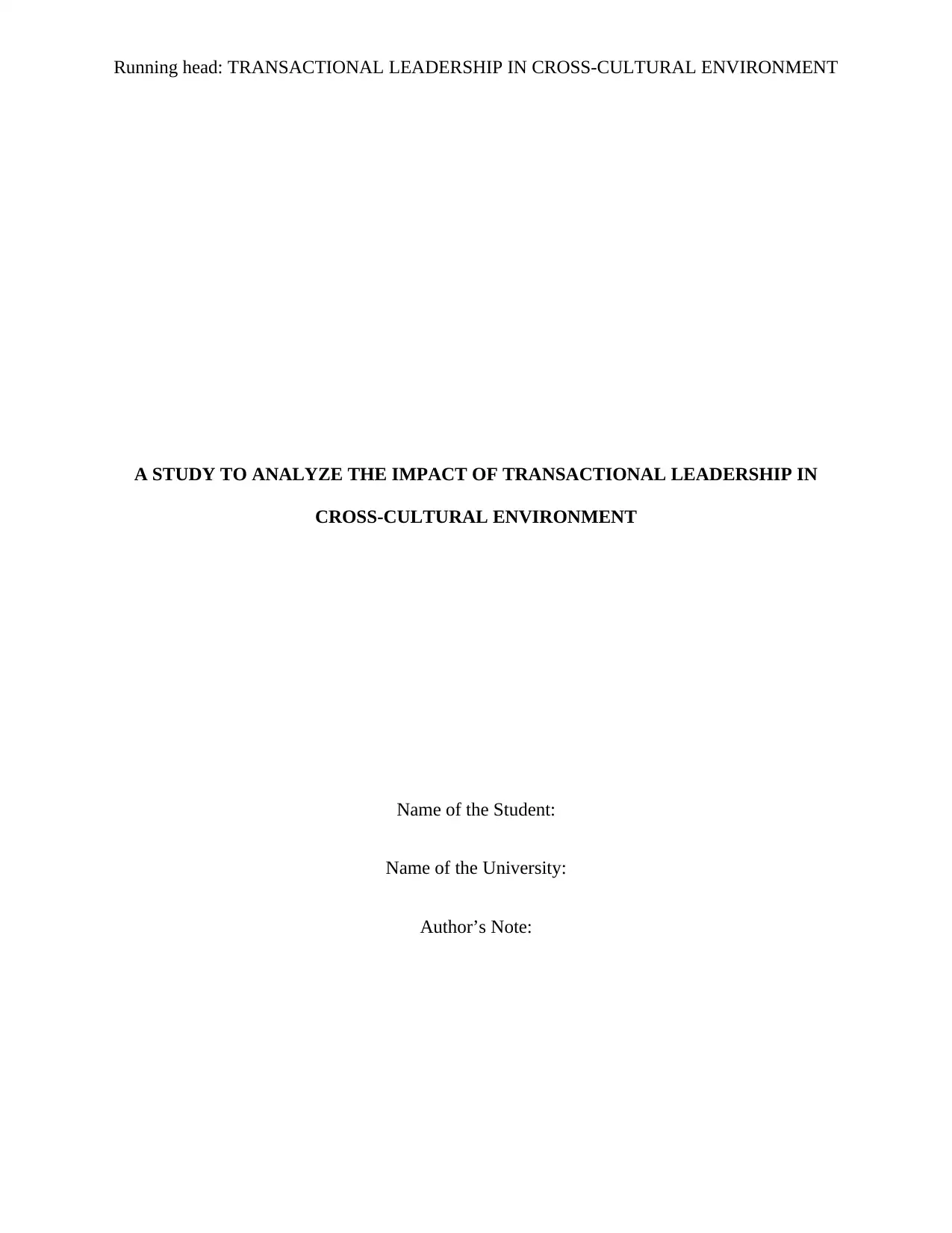
Running head: TRANSACTIONAL LEADERSHIP IN CROSS-CULTURAL ENVIRONMENT
A STUDY TO ANALYZE THE IMPACT OF TRANSACTIONAL LEADERSHIP IN
CROSS-CULTURAL ENVIRONMENT
Name of the Student:
Name of the University:
Author’s Note:
A STUDY TO ANALYZE THE IMPACT OF TRANSACTIONAL LEADERSHIP IN
CROSS-CULTURAL ENVIRONMENT
Name of the Student:
Name of the University:
Author’s Note:
Secure Best Marks with AI Grader
Need help grading? Try our AI Grader for instant feedback on your assignments.
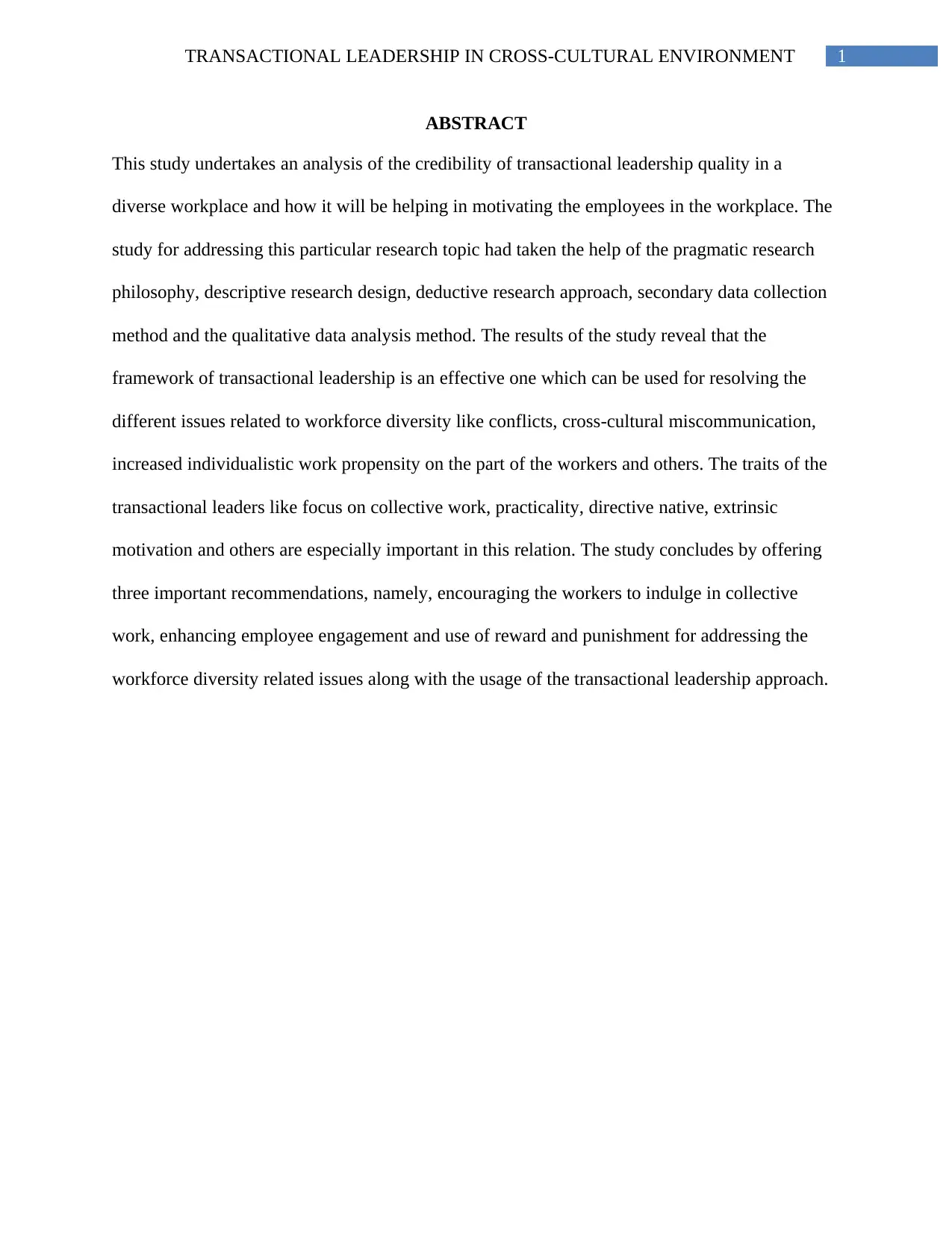
1TRANSACTIONAL LEADERSHIP IN CROSS-CULTURAL ENVIRONMENT
ABSTRACT
This study undertakes an analysis of the credibility of transactional leadership quality in a
diverse workplace and how it will be helping in motivating the employees in the workplace. The
study for addressing this particular research topic had taken the help of the pragmatic research
philosophy, descriptive research design, deductive research approach, secondary data collection
method and the qualitative data analysis method. The results of the study reveal that the
framework of transactional leadership is an effective one which can be used for resolving the
different issues related to workforce diversity like conflicts, cross-cultural miscommunication,
increased individualistic work propensity on the part of the workers and others. The traits of the
transactional leaders like focus on collective work, practicality, directive native, extrinsic
motivation and others are especially important in this relation. The study concludes by offering
three important recommendations, namely, encouraging the workers to indulge in collective
work, enhancing employee engagement and use of reward and punishment for addressing the
workforce diversity related issues along with the usage of the transactional leadership approach.
ABSTRACT
This study undertakes an analysis of the credibility of transactional leadership quality in a
diverse workplace and how it will be helping in motivating the employees in the workplace. The
study for addressing this particular research topic had taken the help of the pragmatic research
philosophy, descriptive research design, deductive research approach, secondary data collection
method and the qualitative data analysis method. The results of the study reveal that the
framework of transactional leadership is an effective one which can be used for resolving the
different issues related to workforce diversity like conflicts, cross-cultural miscommunication,
increased individualistic work propensity on the part of the workers and others. The traits of the
transactional leaders like focus on collective work, practicality, directive native, extrinsic
motivation and others are especially important in this relation. The study concludes by offering
three important recommendations, namely, encouraging the workers to indulge in collective
work, enhancing employee engagement and use of reward and punishment for addressing the
workforce diversity related issues along with the usage of the transactional leadership approach.
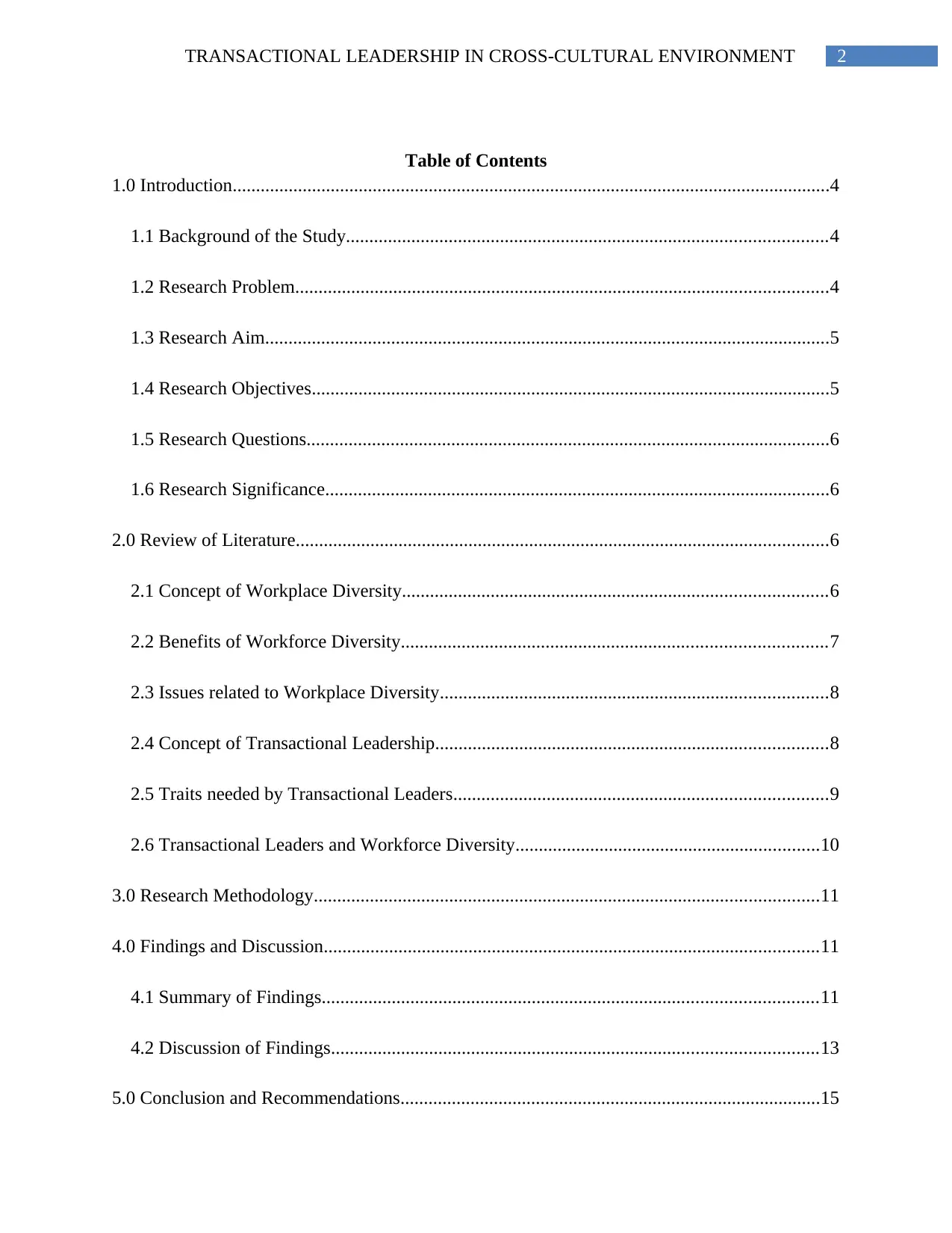
2TRANSACTIONAL LEADERSHIP IN CROSS-CULTURAL ENVIRONMENT
Table of Contents
1.0 Introduction................................................................................................................................4
1.1 Background of the Study.......................................................................................................4
1.2 Research Problem..................................................................................................................4
1.3 Research Aim.........................................................................................................................5
1.4 Research Objectives...............................................................................................................5
1.5 Research Questions................................................................................................................6
1.6 Research Significance............................................................................................................6
2.0 Review of Literature..................................................................................................................6
2.1 Concept of Workplace Diversity...........................................................................................6
2.2 Benefits of Workforce Diversity...........................................................................................7
2.3 Issues related to Workplace Diversity...................................................................................8
2.4 Concept of Transactional Leadership....................................................................................8
2.5 Traits needed by Transactional Leaders................................................................................9
2.6 Transactional Leaders and Workforce Diversity.................................................................10
3.0 Research Methodology............................................................................................................11
4.0 Findings and Discussion..........................................................................................................11
4.1 Summary of Findings..........................................................................................................11
4.2 Discussion of Findings........................................................................................................13
5.0 Conclusion and Recommendations..........................................................................................15
Table of Contents
1.0 Introduction................................................................................................................................4
1.1 Background of the Study.......................................................................................................4
1.2 Research Problem..................................................................................................................4
1.3 Research Aim.........................................................................................................................5
1.4 Research Objectives...............................................................................................................5
1.5 Research Questions................................................................................................................6
1.6 Research Significance............................................................................................................6
2.0 Review of Literature..................................................................................................................6
2.1 Concept of Workplace Diversity...........................................................................................6
2.2 Benefits of Workforce Diversity...........................................................................................7
2.3 Issues related to Workplace Diversity...................................................................................8
2.4 Concept of Transactional Leadership....................................................................................8
2.5 Traits needed by Transactional Leaders................................................................................9
2.6 Transactional Leaders and Workforce Diversity.................................................................10
3.0 Research Methodology............................................................................................................11
4.0 Findings and Discussion..........................................................................................................11
4.1 Summary of Findings..........................................................................................................11
4.2 Discussion of Findings........................................................................................................13
5.0 Conclusion and Recommendations..........................................................................................15
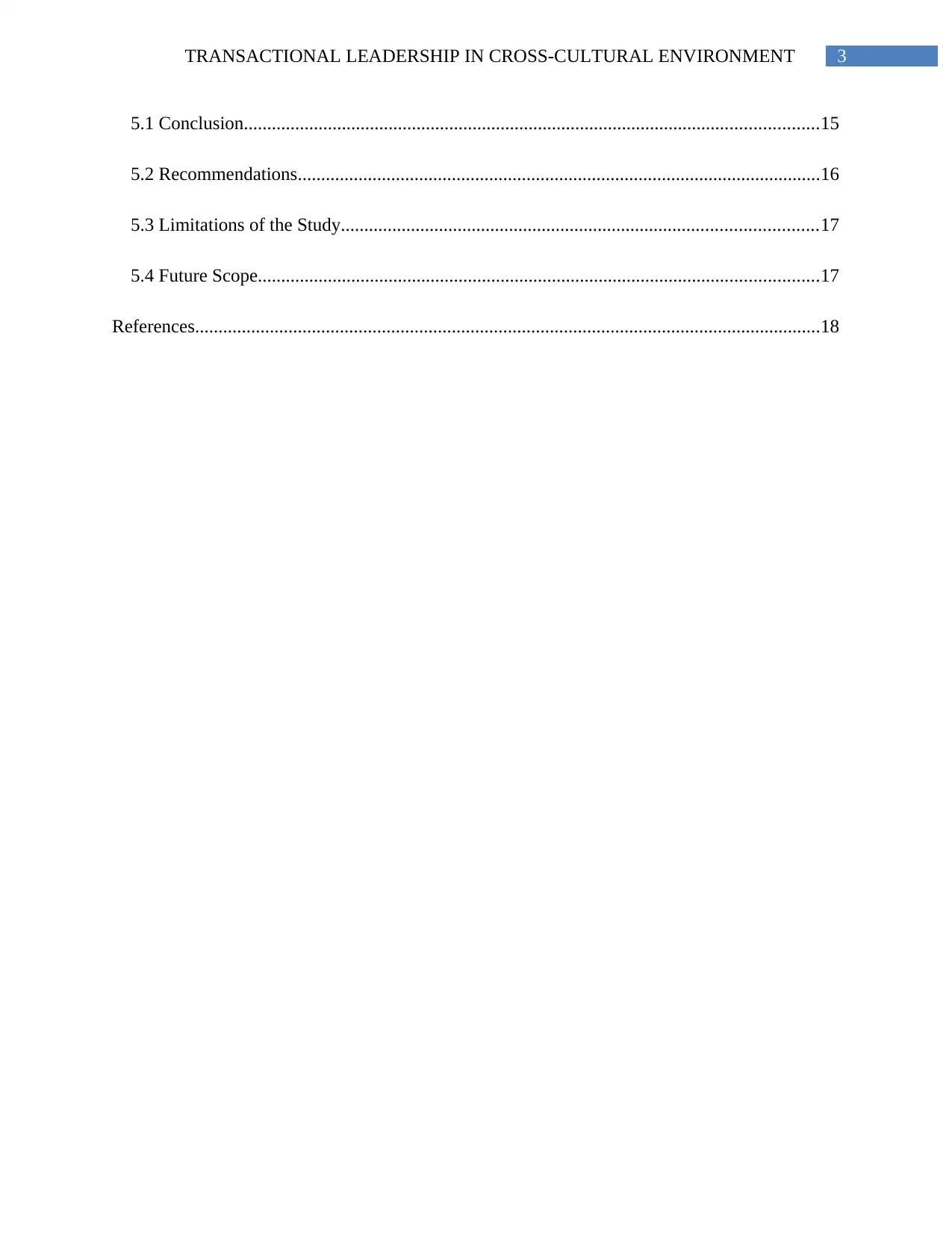
3TRANSACTIONAL LEADERSHIP IN CROSS-CULTURAL ENVIRONMENT
5.1 Conclusion...........................................................................................................................15
5.2 Recommendations................................................................................................................16
5.3 Limitations of the Study......................................................................................................17
5.4 Future Scope........................................................................................................................17
References......................................................................................................................................18
5.1 Conclusion...........................................................................................................................15
5.2 Recommendations................................................................................................................16
5.3 Limitations of the Study......................................................................................................17
5.4 Future Scope........................................................................................................................17
References......................................................................................................................................18
Secure Best Marks with AI Grader
Need help grading? Try our AI Grader for instant feedback on your assignments.
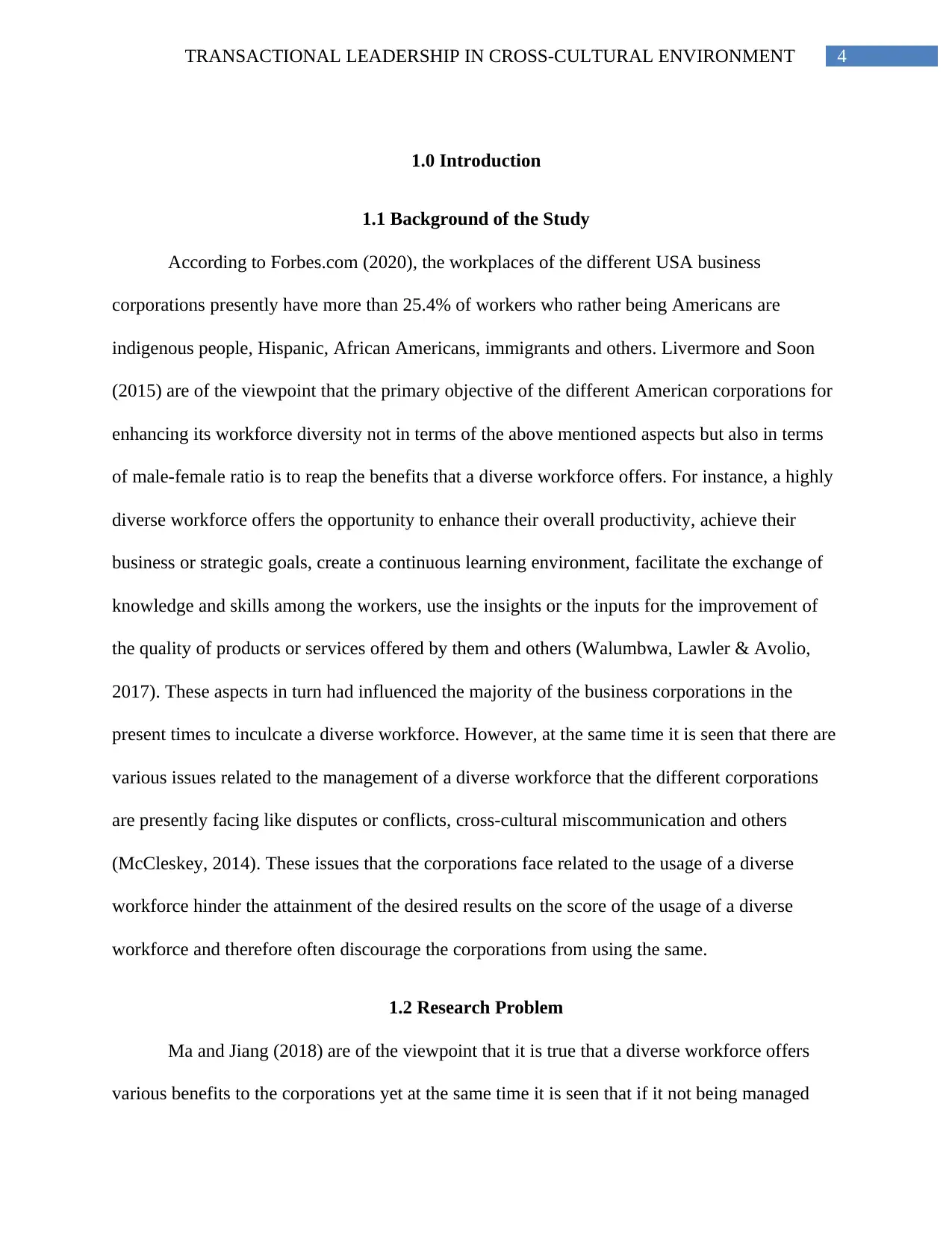
4TRANSACTIONAL LEADERSHIP IN CROSS-CULTURAL ENVIRONMENT
1.0 Introduction
1.1 Background of the Study
According to Forbes.com (2020), the workplaces of the different USA business
corporations presently have more than 25.4% of workers who rather being Americans are
indigenous people, Hispanic, African Americans, immigrants and others. Livermore and Soon
(2015) are of the viewpoint that the primary objective of the different American corporations for
enhancing its workforce diversity not in terms of the above mentioned aspects but also in terms
of male-female ratio is to reap the benefits that a diverse workforce offers. For instance, a highly
diverse workforce offers the opportunity to enhance their overall productivity, achieve their
business or strategic goals, create a continuous learning environment, facilitate the exchange of
knowledge and skills among the workers, use the insights or the inputs for the improvement of
the quality of products or services offered by them and others (Walumbwa, Lawler & Avolio,
2017). These aspects in turn had influenced the majority of the business corporations in the
present times to inculcate a diverse workforce. However, at the same time it is seen that there are
various issues related to the management of a diverse workforce that the different corporations
are presently facing like disputes or conflicts, cross-cultural miscommunication and others
(McCleskey, 2014). These issues that the corporations face related to the usage of a diverse
workforce hinder the attainment of the desired results on the score of the usage of a diverse
workforce and therefore often discourage the corporations from using the same.
1.2 Research Problem
Ma and Jiang (2018) are of the viewpoint that it is true that a diverse workforce offers
various benefits to the corporations yet at the same time it is seen that if it not being managed
1.0 Introduction
1.1 Background of the Study
According to Forbes.com (2020), the workplaces of the different USA business
corporations presently have more than 25.4% of workers who rather being Americans are
indigenous people, Hispanic, African Americans, immigrants and others. Livermore and Soon
(2015) are of the viewpoint that the primary objective of the different American corporations for
enhancing its workforce diversity not in terms of the above mentioned aspects but also in terms
of male-female ratio is to reap the benefits that a diverse workforce offers. For instance, a highly
diverse workforce offers the opportunity to enhance their overall productivity, achieve their
business or strategic goals, create a continuous learning environment, facilitate the exchange of
knowledge and skills among the workers, use the insights or the inputs for the improvement of
the quality of products or services offered by them and others (Walumbwa, Lawler & Avolio,
2017). These aspects in turn had influenced the majority of the business corporations in the
present times to inculcate a diverse workforce. However, at the same time it is seen that there are
various issues related to the management of a diverse workforce that the different corporations
are presently facing like disputes or conflicts, cross-cultural miscommunication and others
(McCleskey, 2014). These issues that the corporations face related to the usage of a diverse
workforce hinder the attainment of the desired results on the score of the usage of a diverse
workforce and therefore often discourage the corporations from using the same.
1.2 Research Problem
Ma and Jiang (2018) are of the viewpoint that it is true that a diverse workforce offers
various benefits to the corporations yet at the same time it is seen that if it not being managed
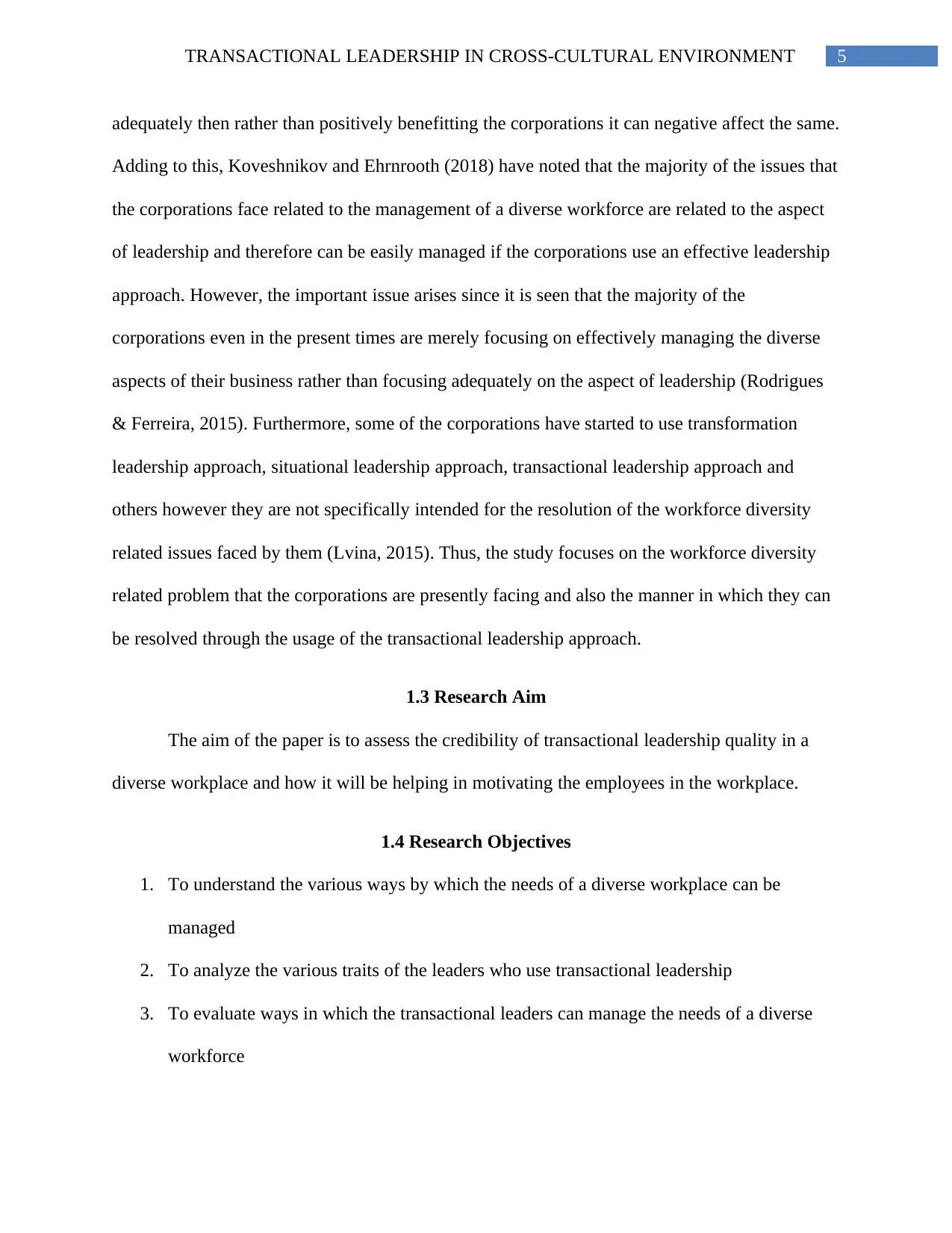
5TRANSACTIONAL LEADERSHIP IN CROSS-CULTURAL ENVIRONMENT
adequately then rather than positively benefitting the corporations it can negative affect the same.
Adding to this, Koveshnikov and Ehrnrooth (2018) have noted that the majority of the issues that
the corporations face related to the management of a diverse workforce are related to the aspect
of leadership and therefore can be easily managed if the corporations use an effective leadership
approach. However, the important issue arises since it is seen that the majority of the
corporations even in the present times are merely focusing on effectively managing the diverse
aspects of their business rather than focusing adequately on the aspect of leadership (Rodrigues
& Ferreira, 2015). Furthermore, some of the corporations have started to use transformation
leadership approach, situational leadership approach, transactional leadership approach and
others however they are not specifically intended for the resolution of the workforce diversity
related issues faced by them (Lvina, 2015). Thus, the study focuses on the workforce diversity
related problem that the corporations are presently facing and also the manner in which they can
be resolved through the usage of the transactional leadership approach.
1.3 Research Aim
The aim of the paper is to assess the credibility of transactional leadership quality in a
diverse workplace and how it will be helping in motivating the employees in the workplace.
1.4 Research Objectives
1. To understand the various ways by which the needs of a diverse workplace can be
managed
2. To analyze the various traits of the leaders who use transactional leadership
3. To evaluate ways in which the transactional leaders can manage the needs of a diverse
workforce
adequately then rather than positively benefitting the corporations it can negative affect the same.
Adding to this, Koveshnikov and Ehrnrooth (2018) have noted that the majority of the issues that
the corporations face related to the management of a diverse workforce are related to the aspect
of leadership and therefore can be easily managed if the corporations use an effective leadership
approach. However, the important issue arises since it is seen that the majority of the
corporations even in the present times are merely focusing on effectively managing the diverse
aspects of their business rather than focusing adequately on the aspect of leadership (Rodrigues
& Ferreira, 2015). Furthermore, some of the corporations have started to use transformation
leadership approach, situational leadership approach, transactional leadership approach and
others however they are not specifically intended for the resolution of the workforce diversity
related issues faced by them (Lvina, 2015). Thus, the study focuses on the workforce diversity
related problem that the corporations are presently facing and also the manner in which they can
be resolved through the usage of the transactional leadership approach.
1.3 Research Aim
The aim of the paper is to assess the credibility of transactional leadership quality in a
diverse workplace and how it will be helping in motivating the employees in the workplace.
1.4 Research Objectives
1. To understand the various ways by which the needs of a diverse workplace can be
managed
2. To analyze the various traits of the leaders who use transactional leadership
3. To evaluate ways in which the transactional leaders can manage the needs of a diverse
workforce
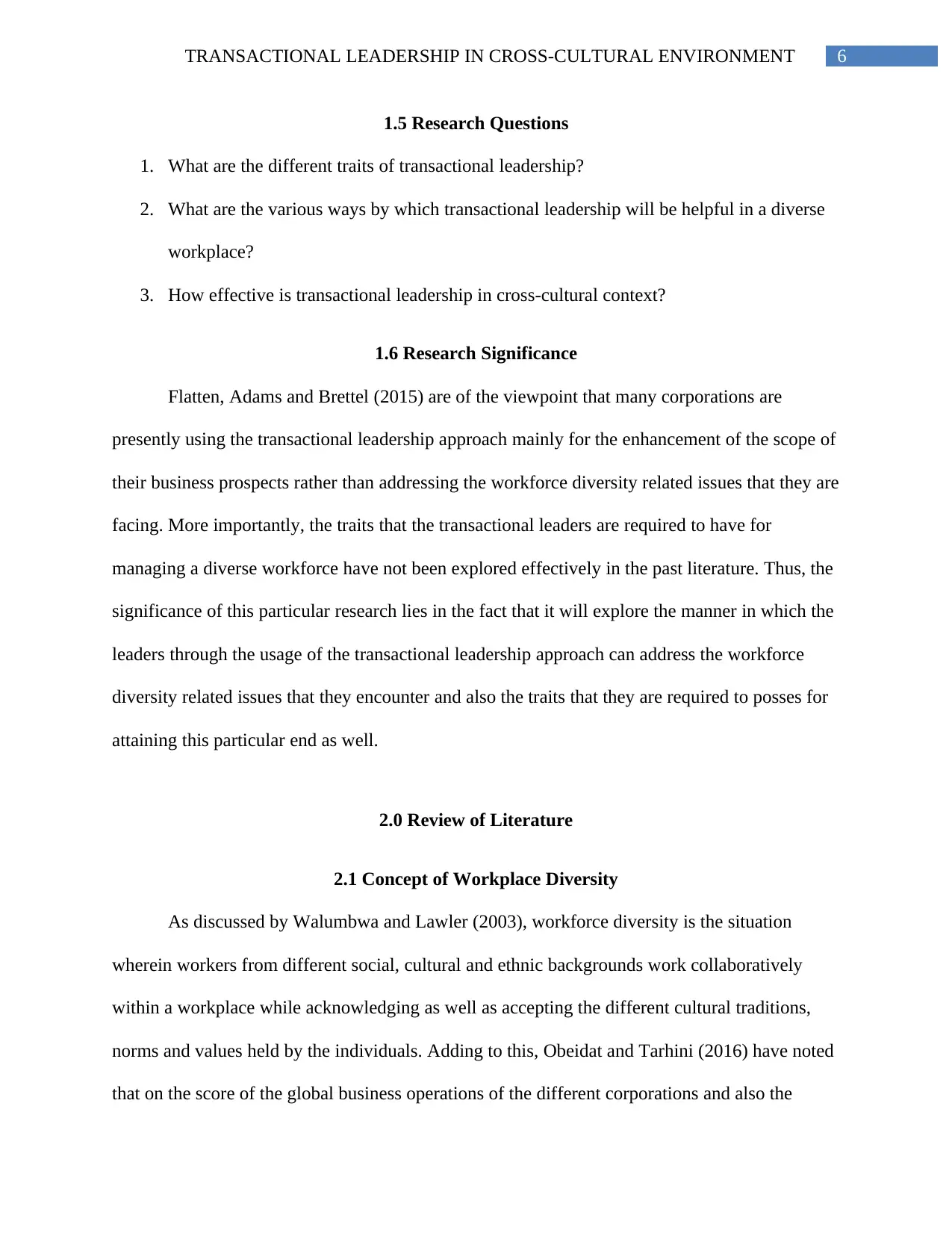
6TRANSACTIONAL LEADERSHIP IN CROSS-CULTURAL ENVIRONMENT
1.5 Research Questions
1. What are the different traits of transactional leadership?
2. What are the various ways by which transactional leadership will be helpful in a diverse
workplace?
3. How effective is transactional leadership in cross-cultural context?
1.6 Research Significance
Flatten, Adams and Brettel (2015) are of the viewpoint that many corporations are
presently using the transactional leadership approach mainly for the enhancement of the scope of
their business prospects rather than addressing the workforce diversity related issues that they are
facing. More importantly, the traits that the transactional leaders are required to have for
managing a diverse workforce have not been explored effectively in the past literature. Thus, the
significance of this particular research lies in the fact that it will explore the manner in which the
leaders through the usage of the transactional leadership approach can address the workforce
diversity related issues that they encounter and also the traits that they are required to posses for
attaining this particular end as well.
2.0 Review of Literature
2.1 Concept of Workplace Diversity
As discussed by Walumbwa and Lawler (2003), workforce diversity is the situation
wherein workers from different social, cultural and ethnic backgrounds work collaboratively
within a workplace while acknowledging as well as accepting the different cultural traditions,
norms and values held by the individuals. Adding to this, Obeidat and Tarhini (2016) have noted
that on the score of the global business operations of the different corporations and also the
1.5 Research Questions
1. What are the different traits of transactional leadership?
2. What are the various ways by which transactional leadership will be helpful in a diverse
workplace?
3. How effective is transactional leadership in cross-cultural context?
1.6 Research Significance
Flatten, Adams and Brettel (2015) are of the viewpoint that many corporations are
presently using the transactional leadership approach mainly for the enhancement of the scope of
their business prospects rather than addressing the workforce diversity related issues that they are
facing. More importantly, the traits that the transactional leaders are required to have for
managing a diverse workforce have not been explored effectively in the past literature. Thus, the
significance of this particular research lies in the fact that it will explore the manner in which the
leaders through the usage of the transactional leadership approach can address the workforce
diversity related issues that they encounter and also the traits that they are required to posses for
attaining this particular end as well.
2.0 Review of Literature
2.1 Concept of Workplace Diversity
As discussed by Walumbwa and Lawler (2003), workforce diversity is the situation
wherein workers from different social, cultural and ethnic backgrounds work collaboratively
within a workplace while acknowledging as well as accepting the different cultural traditions,
norms and values held by the individuals. Adding to this, Obeidat and Tarhini (2016) have noted
that on the score of the global business operations of the different corporations and also the
Paraphrase This Document
Need a fresh take? Get an instant paraphrase of this document with our AI Paraphraser
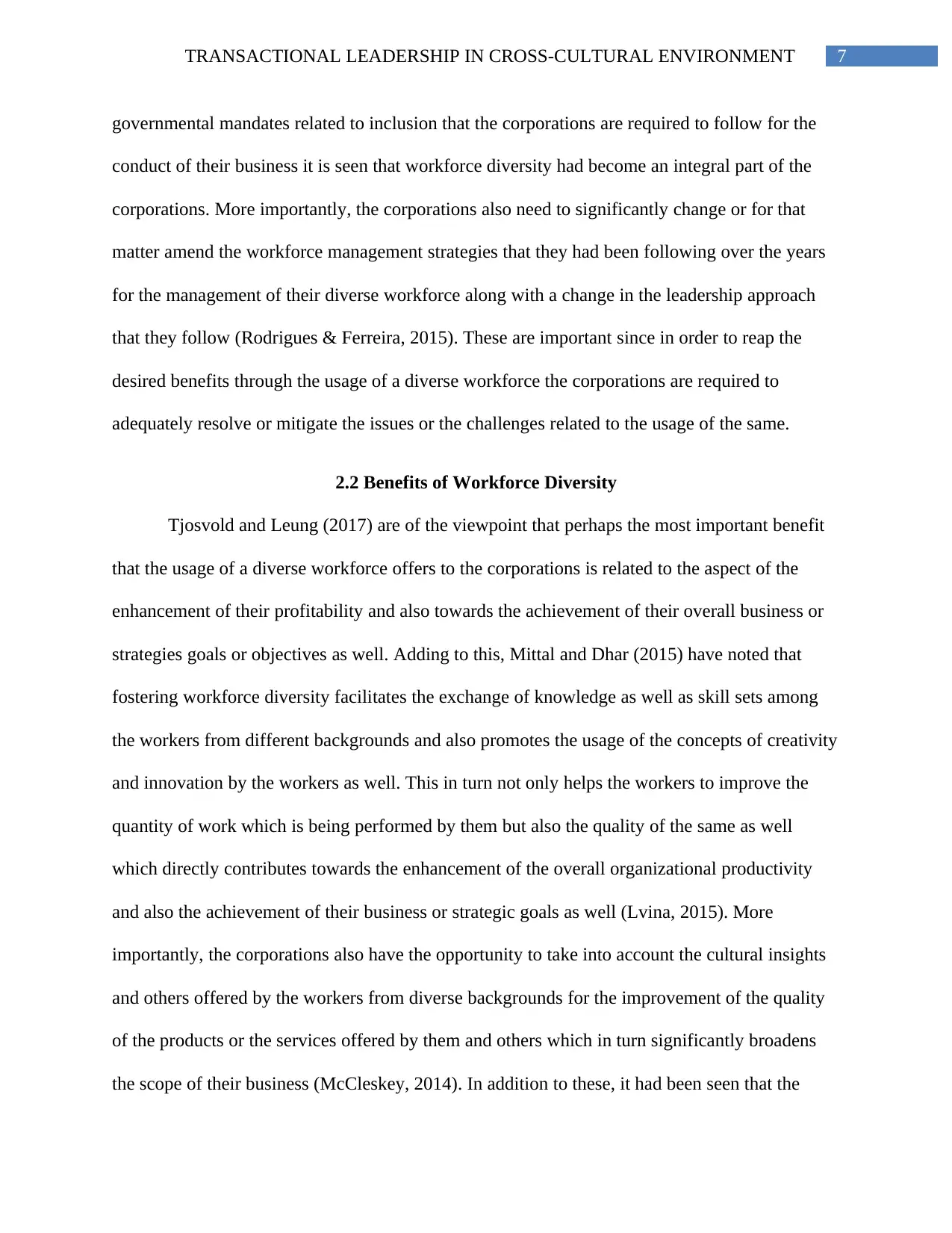
7TRANSACTIONAL LEADERSHIP IN CROSS-CULTURAL ENVIRONMENT
governmental mandates related to inclusion that the corporations are required to follow for the
conduct of their business it is seen that workforce diversity had become an integral part of the
corporations. More importantly, the corporations also need to significantly change or for that
matter amend the workforce management strategies that they had been following over the years
for the management of their diverse workforce along with a change in the leadership approach
that they follow (Rodrigues & Ferreira, 2015). These are important since in order to reap the
desired benefits through the usage of a diverse workforce the corporations are required to
adequately resolve or mitigate the issues or the challenges related to the usage of the same.
2.2 Benefits of Workforce Diversity
Tjosvold and Leung (2017) are of the viewpoint that perhaps the most important benefit
that the usage of a diverse workforce offers to the corporations is related to the aspect of the
enhancement of their profitability and also towards the achievement of their overall business or
strategies goals or objectives as well. Adding to this, Mittal and Dhar (2015) have noted that
fostering workforce diversity facilitates the exchange of knowledge as well as skill sets among
the workers from different backgrounds and also promotes the usage of the concepts of creativity
and innovation by the workers as well. This in turn not only helps the workers to improve the
quantity of work which is being performed by them but also the quality of the same as well
which directly contributes towards the enhancement of the overall organizational productivity
and also the achievement of their business or strategic goals as well (Lvina, 2015). More
importantly, the corporations also have the opportunity to take into account the cultural insights
and others offered by the workers from diverse backgrounds for the improvement of the quality
of the products or the services offered by them and others which in turn significantly broadens
the scope of their business (McCleskey, 2014). In addition to these, it had been seen that the
governmental mandates related to inclusion that the corporations are required to follow for the
conduct of their business it is seen that workforce diversity had become an integral part of the
corporations. More importantly, the corporations also need to significantly change or for that
matter amend the workforce management strategies that they had been following over the years
for the management of their diverse workforce along with a change in the leadership approach
that they follow (Rodrigues & Ferreira, 2015). These are important since in order to reap the
desired benefits through the usage of a diverse workforce the corporations are required to
adequately resolve or mitigate the issues or the challenges related to the usage of the same.
2.2 Benefits of Workforce Diversity
Tjosvold and Leung (2017) are of the viewpoint that perhaps the most important benefit
that the usage of a diverse workforce offers to the corporations is related to the aspect of the
enhancement of their profitability and also towards the achievement of their overall business or
strategies goals or objectives as well. Adding to this, Mittal and Dhar (2015) have noted that
fostering workforce diversity facilitates the exchange of knowledge as well as skill sets among
the workers from different backgrounds and also promotes the usage of the concepts of creativity
and innovation by the workers as well. This in turn not only helps the workers to improve the
quantity of work which is being performed by them but also the quality of the same as well
which directly contributes towards the enhancement of the overall organizational productivity
and also the achievement of their business or strategic goals as well (Lvina, 2015). More
importantly, the corporations also have the opportunity to take into account the cultural insights
and others offered by the workers from diverse backgrounds for the improvement of the quality
of the products or the services offered by them and others which in turn significantly broadens
the scope of their business (McCleskey, 2014). In addition to these, it had been seen that the
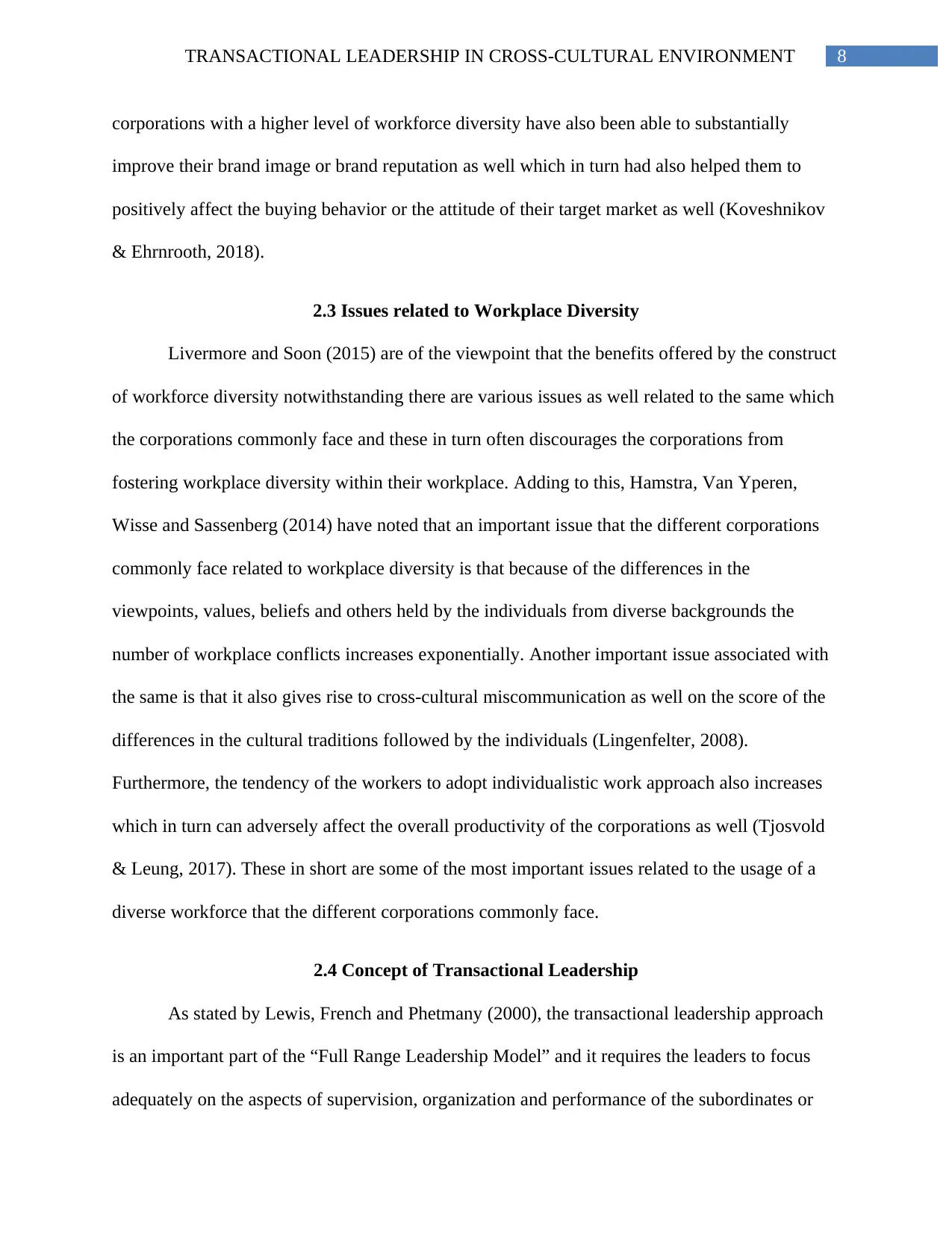
8TRANSACTIONAL LEADERSHIP IN CROSS-CULTURAL ENVIRONMENT
corporations with a higher level of workforce diversity have also been able to substantially
improve their brand image or brand reputation as well which in turn had also helped them to
positively affect the buying behavior or the attitude of their target market as well (Koveshnikov
& Ehrnrooth, 2018).
2.3 Issues related to Workplace Diversity
Livermore and Soon (2015) are of the viewpoint that the benefits offered by the construct
of workforce diversity notwithstanding there are various issues as well related to the same which
the corporations commonly face and these in turn often discourages the corporations from
fostering workplace diversity within their workplace. Adding to this, Hamstra, Van Yperen,
Wisse and Sassenberg (2014) have noted that an important issue that the different corporations
commonly face related to workplace diversity is that because of the differences in the
viewpoints, values, beliefs and others held by the individuals from diverse backgrounds the
number of workplace conflicts increases exponentially. Another important issue associated with
the same is that it also gives rise to cross-cultural miscommunication as well on the score of the
differences in the cultural traditions followed by the individuals (Lingenfelter, 2008).
Furthermore, the tendency of the workers to adopt individualistic work approach also increases
which in turn can adversely affect the overall productivity of the corporations as well (Tjosvold
& Leung, 2017). These in short are some of the most important issues related to the usage of a
diverse workforce that the different corporations commonly face.
2.4 Concept of Transactional Leadership
As stated by Lewis, French and Phetmany (2000), the transactional leadership approach
is an important part of the “Full Range Leadership Model” and it requires the leaders to focus
adequately on the aspects of supervision, organization and performance of the subordinates or
corporations with a higher level of workforce diversity have also been able to substantially
improve their brand image or brand reputation as well which in turn had also helped them to
positively affect the buying behavior or the attitude of their target market as well (Koveshnikov
& Ehrnrooth, 2018).
2.3 Issues related to Workplace Diversity
Livermore and Soon (2015) are of the viewpoint that the benefits offered by the construct
of workforce diversity notwithstanding there are various issues as well related to the same which
the corporations commonly face and these in turn often discourages the corporations from
fostering workplace diversity within their workplace. Adding to this, Hamstra, Van Yperen,
Wisse and Sassenberg (2014) have noted that an important issue that the different corporations
commonly face related to workplace diversity is that because of the differences in the
viewpoints, values, beliefs and others held by the individuals from diverse backgrounds the
number of workplace conflicts increases exponentially. Another important issue associated with
the same is that it also gives rise to cross-cultural miscommunication as well on the score of the
differences in the cultural traditions followed by the individuals (Lingenfelter, 2008).
Furthermore, the tendency of the workers to adopt individualistic work approach also increases
which in turn can adversely affect the overall productivity of the corporations as well (Tjosvold
& Leung, 2017). These in short are some of the most important issues related to the usage of a
diverse workforce that the different corporations commonly face.
2.4 Concept of Transactional Leadership
As stated by Lewis, French and Phetmany (2000), the transactional leadership approach
is an important part of the “Full Range Leadership Model” and it requires the leaders to focus
adequately on the aspects of supervision, organization and performance of the subordinates or
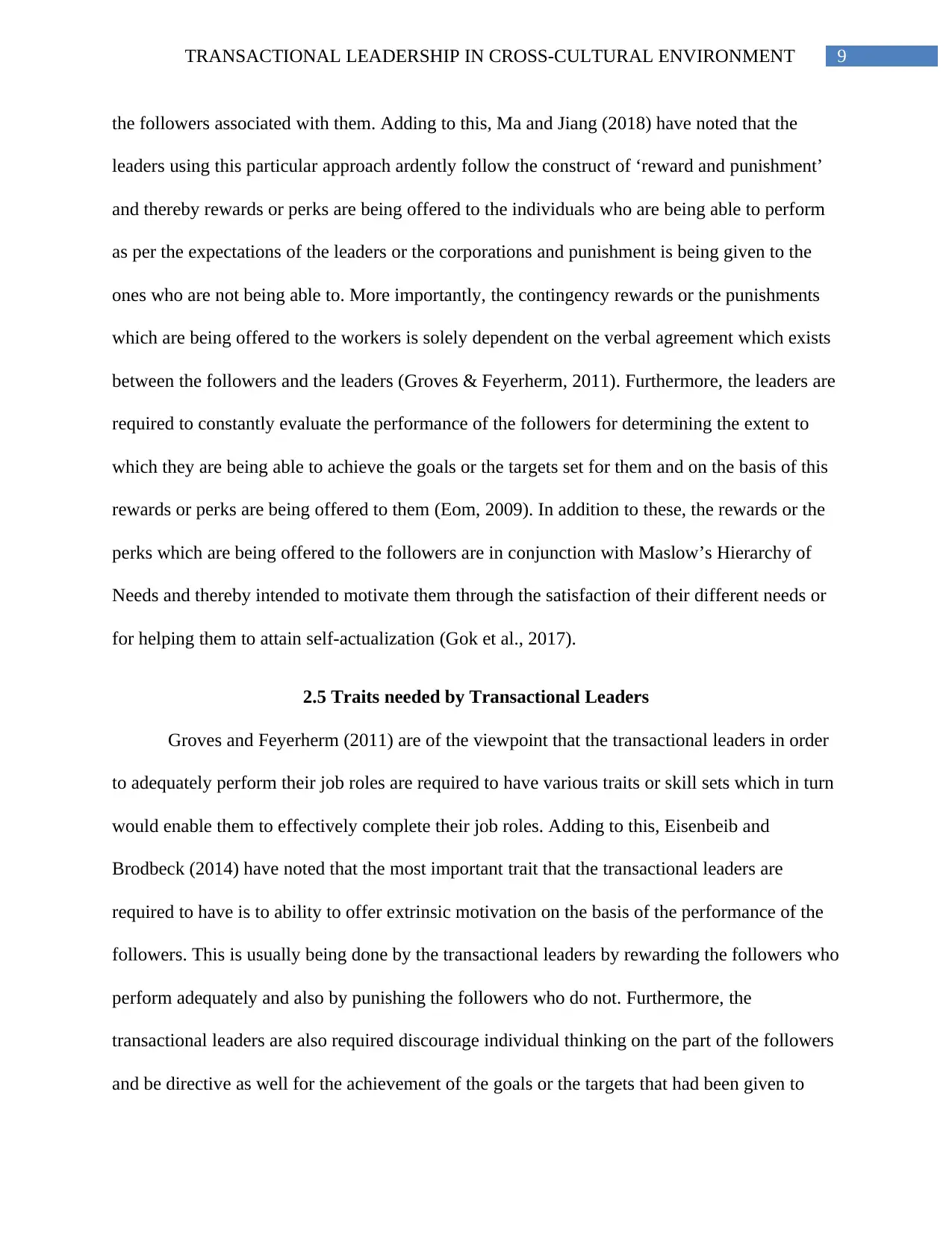
9TRANSACTIONAL LEADERSHIP IN CROSS-CULTURAL ENVIRONMENT
the followers associated with them. Adding to this, Ma and Jiang (2018) have noted that the
leaders using this particular approach ardently follow the construct of ‘reward and punishment’
and thereby rewards or perks are being offered to the individuals who are being able to perform
as per the expectations of the leaders or the corporations and punishment is being given to the
ones who are not being able to. More importantly, the contingency rewards or the punishments
which are being offered to the workers is solely dependent on the verbal agreement which exists
between the followers and the leaders (Groves & Feyerherm, 2011). Furthermore, the leaders are
required to constantly evaluate the performance of the followers for determining the extent to
which they are being able to achieve the goals or the targets set for them and on the basis of this
rewards or perks are being offered to them (Eom, 2009). In addition to these, the rewards or the
perks which are being offered to the followers are in conjunction with Maslow’s Hierarchy of
Needs and thereby intended to motivate them through the satisfaction of their different needs or
for helping them to attain self-actualization (Gok et al., 2017).
2.5 Traits needed by Transactional Leaders
Groves and Feyerherm (2011) are of the viewpoint that the transactional leaders in order
to adequately perform their job roles are required to have various traits or skill sets which in turn
would enable them to effectively complete their job roles. Adding to this, Eisenbeib and
Brodbeck (2014) have noted that the most important trait that the transactional leaders are
required to have is to ability to offer extrinsic motivation on the basis of the performance of the
followers. This is usually being done by the transactional leaders by rewarding the followers who
perform adequately and also by punishing the followers who do not. Furthermore, the
transactional leaders are also required discourage individual thinking on the part of the followers
and be directive as well for the achievement of the goals or the targets that had been given to
the followers associated with them. Adding to this, Ma and Jiang (2018) have noted that the
leaders using this particular approach ardently follow the construct of ‘reward and punishment’
and thereby rewards or perks are being offered to the individuals who are being able to perform
as per the expectations of the leaders or the corporations and punishment is being given to the
ones who are not being able to. More importantly, the contingency rewards or the punishments
which are being offered to the workers is solely dependent on the verbal agreement which exists
between the followers and the leaders (Groves & Feyerherm, 2011). Furthermore, the leaders are
required to constantly evaluate the performance of the followers for determining the extent to
which they are being able to achieve the goals or the targets set for them and on the basis of this
rewards or perks are being offered to them (Eom, 2009). In addition to these, the rewards or the
perks which are being offered to the followers are in conjunction with Maslow’s Hierarchy of
Needs and thereby intended to motivate them through the satisfaction of their different needs or
for helping them to attain self-actualization (Gok et al., 2017).
2.5 Traits needed by Transactional Leaders
Groves and Feyerherm (2011) are of the viewpoint that the transactional leaders in order
to adequately perform their job roles are required to have various traits or skill sets which in turn
would enable them to effectively complete their job roles. Adding to this, Eisenbeib and
Brodbeck (2014) have noted that the most important trait that the transactional leaders are
required to have is to ability to offer extrinsic motivation on the basis of the performance of the
followers. This is usually being done by the transactional leaders by rewarding the followers who
perform adequately and also by punishing the followers who do not. Furthermore, the
transactional leaders are also required discourage individual thinking on the part of the followers
and be directive as well for the achievement of the goals or the targets that had been given to
Secure Best Marks with AI Grader
Need help grading? Try our AI Grader for instant feedback on your assignments.
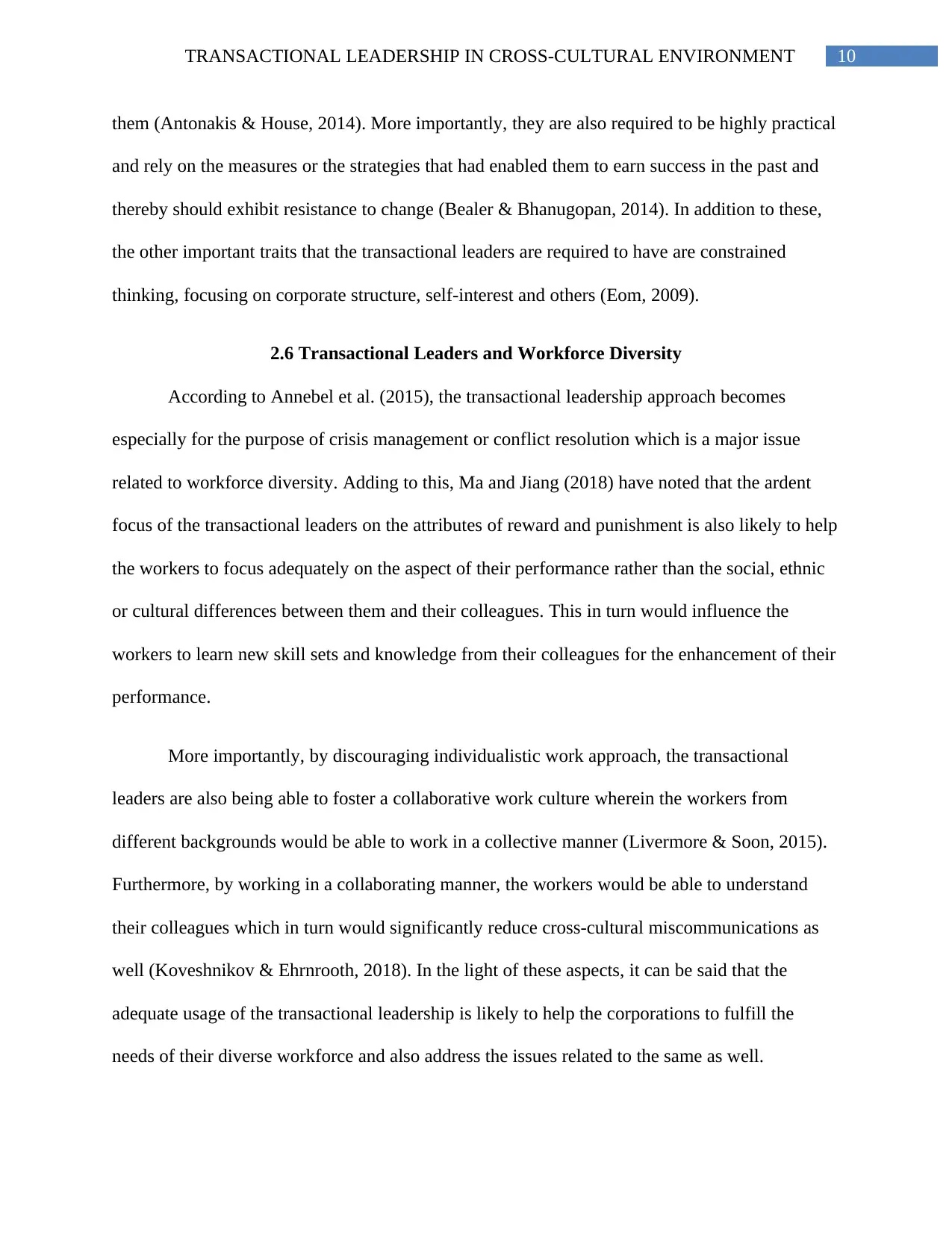
10TRANSACTIONAL LEADERSHIP IN CROSS-CULTURAL ENVIRONMENT
them (Antonakis & House, 2014). More importantly, they are also required to be highly practical
and rely on the measures or the strategies that had enabled them to earn success in the past and
thereby should exhibit resistance to change (Bealer & Bhanugopan, 2014). In addition to these,
the other important traits that the transactional leaders are required to have are constrained
thinking, focusing on corporate structure, self-interest and others (Eom, 2009).
2.6 Transactional Leaders and Workforce Diversity
According to Annebel et al. (2015), the transactional leadership approach becomes
especially for the purpose of crisis management or conflict resolution which is a major issue
related to workforce diversity. Adding to this, Ma and Jiang (2018) have noted that the ardent
focus of the transactional leaders on the attributes of reward and punishment is also likely to help
the workers to focus adequately on the aspect of their performance rather than the social, ethnic
or cultural differences between them and their colleagues. This in turn would influence the
workers to learn new skill sets and knowledge from their colleagues for the enhancement of their
performance.
More importantly, by discouraging individualistic work approach, the transactional
leaders are also being able to foster a collaborative work culture wherein the workers from
different backgrounds would be able to work in a collective manner (Livermore & Soon, 2015).
Furthermore, by working in a collaborating manner, the workers would be able to understand
their colleagues which in turn would significantly reduce cross-cultural miscommunications as
well (Koveshnikov & Ehrnrooth, 2018). In the light of these aspects, it can be said that the
adequate usage of the transactional leadership is likely to help the corporations to fulfill the
needs of their diverse workforce and also address the issues related to the same as well.
them (Antonakis & House, 2014). More importantly, they are also required to be highly practical
and rely on the measures or the strategies that had enabled them to earn success in the past and
thereby should exhibit resistance to change (Bealer & Bhanugopan, 2014). In addition to these,
the other important traits that the transactional leaders are required to have are constrained
thinking, focusing on corporate structure, self-interest and others (Eom, 2009).
2.6 Transactional Leaders and Workforce Diversity
According to Annebel et al. (2015), the transactional leadership approach becomes
especially for the purpose of crisis management or conflict resolution which is a major issue
related to workforce diversity. Adding to this, Ma and Jiang (2018) have noted that the ardent
focus of the transactional leaders on the attributes of reward and punishment is also likely to help
the workers to focus adequately on the aspect of their performance rather than the social, ethnic
or cultural differences between them and their colleagues. This in turn would influence the
workers to learn new skill sets and knowledge from their colleagues for the enhancement of their
performance.
More importantly, by discouraging individualistic work approach, the transactional
leaders are also being able to foster a collaborative work culture wherein the workers from
different backgrounds would be able to work in a collective manner (Livermore & Soon, 2015).
Furthermore, by working in a collaborating manner, the workers would be able to understand
their colleagues which in turn would significantly reduce cross-cultural miscommunications as
well (Koveshnikov & Ehrnrooth, 2018). In the light of these aspects, it can be said that the
adequate usage of the transactional leadership is likely to help the corporations to fulfill the
needs of their diverse workforce and also address the issues related to the same as well.
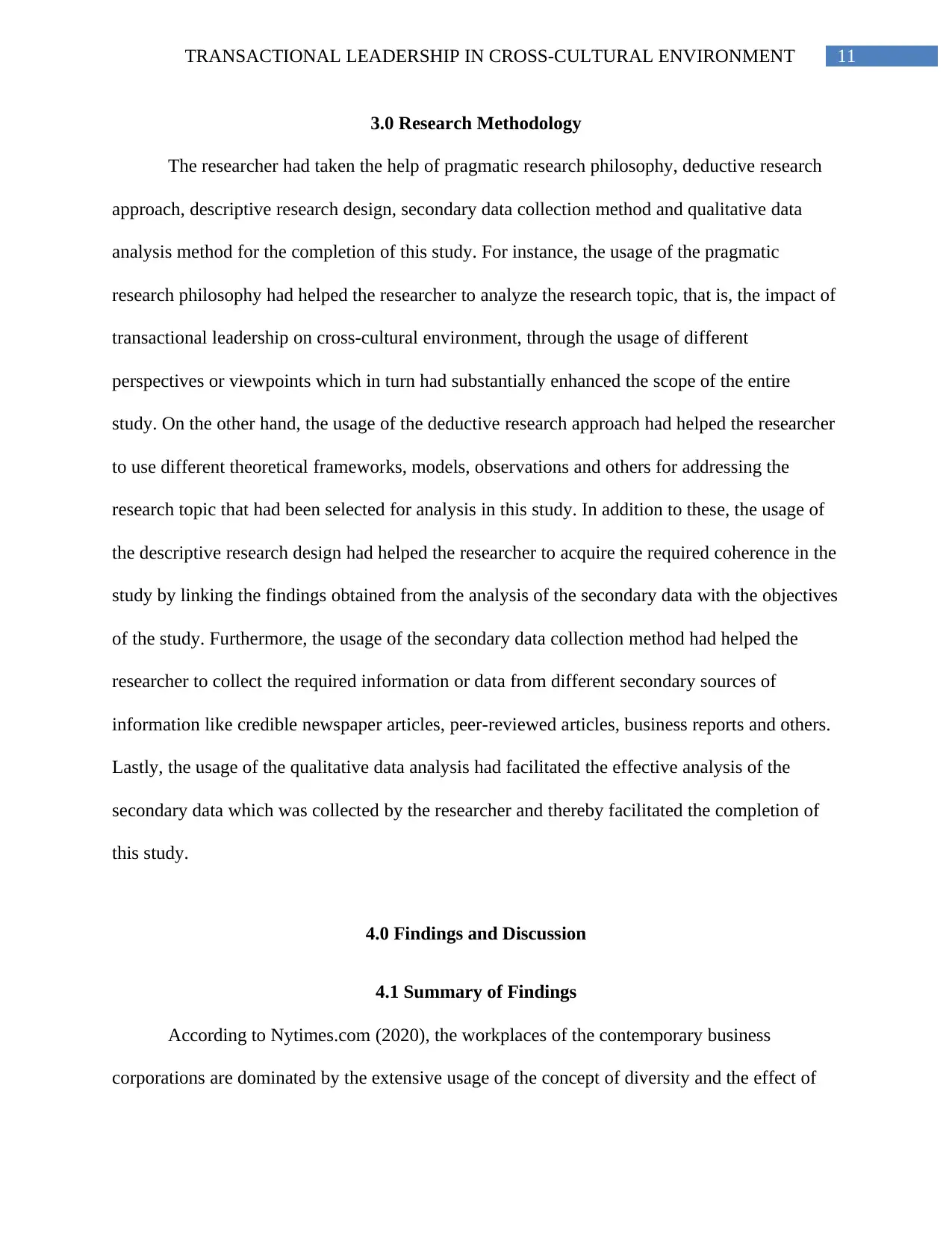
11TRANSACTIONAL LEADERSHIP IN CROSS-CULTURAL ENVIRONMENT
3.0 Research Methodology
The researcher had taken the help of pragmatic research philosophy, deductive research
approach, descriptive research design, secondary data collection method and qualitative data
analysis method for the completion of this study. For instance, the usage of the pragmatic
research philosophy had helped the researcher to analyze the research topic, that is, the impact of
transactional leadership on cross-cultural environment, through the usage of different
perspectives or viewpoints which in turn had substantially enhanced the scope of the entire
study. On the other hand, the usage of the deductive research approach had helped the researcher
to use different theoretical frameworks, models, observations and others for addressing the
research topic that had been selected for analysis in this study. In addition to these, the usage of
the descriptive research design had helped the researcher to acquire the required coherence in the
study by linking the findings obtained from the analysis of the secondary data with the objectives
of the study. Furthermore, the usage of the secondary data collection method had helped the
researcher to collect the required information or data from different secondary sources of
information like credible newspaper articles, peer-reviewed articles, business reports and others.
Lastly, the usage of the qualitative data analysis had facilitated the effective analysis of the
secondary data which was collected by the researcher and thereby facilitated the completion of
this study.
4.0 Findings and Discussion
4.1 Summary of Findings
According to Nytimes.com (2020), the workplaces of the contemporary business
corporations are dominated by the extensive usage of the concept of diversity and the effect of
3.0 Research Methodology
The researcher had taken the help of pragmatic research philosophy, deductive research
approach, descriptive research design, secondary data collection method and qualitative data
analysis method for the completion of this study. For instance, the usage of the pragmatic
research philosophy had helped the researcher to analyze the research topic, that is, the impact of
transactional leadership on cross-cultural environment, through the usage of different
perspectives or viewpoints which in turn had substantially enhanced the scope of the entire
study. On the other hand, the usage of the deductive research approach had helped the researcher
to use different theoretical frameworks, models, observations and others for addressing the
research topic that had been selected for analysis in this study. In addition to these, the usage of
the descriptive research design had helped the researcher to acquire the required coherence in the
study by linking the findings obtained from the analysis of the secondary data with the objectives
of the study. Furthermore, the usage of the secondary data collection method had helped the
researcher to collect the required information or data from different secondary sources of
information like credible newspaper articles, peer-reviewed articles, business reports and others.
Lastly, the usage of the qualitative data analysis had facilitated the effective analysis of the
secondary data which was collected by the researcher and thereby facilitated the completion of
this study.
4.0 Findings and Discussion
4.1 Summary of Findings
According to Nytimes.com (2020), the workplaces of the contemporary business
corporations are dominated by the extensive usage of the concept of diversity and the effect of
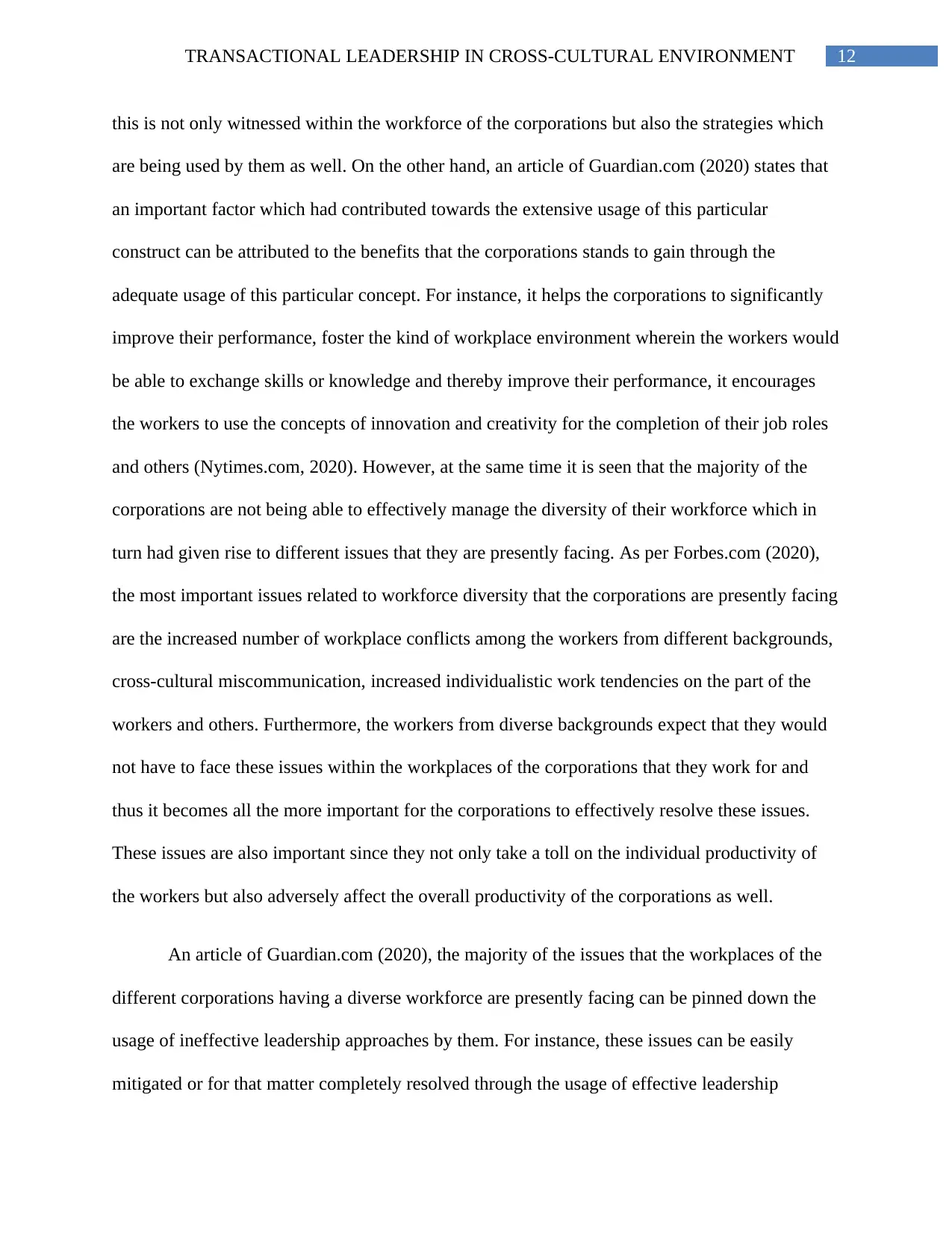
12TRANSACTIONAL LEADERSHIP IN CROSS-CULTURAL ENVIRONMENT
this is not only witnessed within the workforce of the corporations but also the strategies which
are being used by them as well. On the other hand, an article of Guardian.com (2020) states that
an important factor which had contributed towards the extensive usage of this particular
construct can be attributed to the benefits that the corporations stands to gain through the
adequate usage of this particular concept. For instance, it helps the corporations to significantly
improve their performance, foster the kind of workplace environment wherein the workers would
be able to exchange skills or knowledge and thereby improve their performance, it encourages
the workers to use the concepts of innovation and creativity for the completion of their job roles
and others (Nytimes.com, 2020). However, at the same time it is seen that the majority of the
corporations are not being able to effectively manage the diversity of their workforce which in
turn had given rise to different issues that they are presently facing. As per Forbes.com (2020),
the most important issues related to workforce diversity that the corporations are presently facing
are the increased number of workplace conflicts among the workers from different backgrounds,
cross-cultural miscommunication, increased individualistic work tendencies on the part of the
workers and others. Furthermore, the workers from diverse backgrounds expect that they would
not have to face these issues within the workplaces of the corporations that they work for and
thus it becomes all the more important for the corporations to effectively resolve these issues.
These issues are also important since they not only take a toll on the individual productivity of
the workers but also adversely affect the overall productivity of the corporations as well.
An article of Guardian.com (2020), the majority of the issues that the workplaces of the
different corporations having a diverse workforce are presently facing can be pinned down the
usage of ineffective leadership approaches by them. For instance, these issues can be easily
mitigated or for that matter completely resolved through the usage of effective leadership
this is not only witnessed within the workforce of the corporations but also the strategies which
are being used by them as well. On the other hand, an article of Guardian.com (2020) states that
an important factor which had contributed towards the extensive usage of this particular
construct can be attributed to the benefits that the corporations stands to gain through the
adequate usage of this particular concept. For instance, it helps the corporations to significantly
improve their performance, foster the kind of workplace environment wherein the workers would
be able to exchange skills or knowledge and thereby improve their performance, it encourages
the workers to use the concepts of innovation and creativity for the completion of their job roles
and others (Nytimes.com, 2020). However, at the same time it is seen that the majority of the
corporations are not being able to effectively manage the diversity of their workforce which in
turn had given rise to different issues that they are presently facing. As per Forbes.com (2020),
the most important issues related to workforce diversity that the corporations are presently facing
are the increased number of workplace conflicts among the workers from different backgrounds,
cross-cultural miscommunication, increased individualistic work tendencies on the part of the
workers and others. Furthermore, the workers from diverse backgrounds expect that they would
not have to face these issues within the workplaces of the corporations that they work for and
thus it becomes all the more important for the corporations to effectively resolve these issues.
These issues are also important since they not only take a toll on the individual productivity of
the workers but also adversely affect the overall productivity of the corporations as well.
An article of Guardian.com (2020), the majority of the issues that the workplaces of the
different corporations having a diverse workforce are presently facing can be pinned down the
usage of ineffective leadership approaches by them. For instance, these issues can be easily
mitigated or for that matter completely resolved through the usage of effective leadership
Paraphrase This Document
Need a fresh take? Get an instant paraphrase of this document with our AI Paraphraser
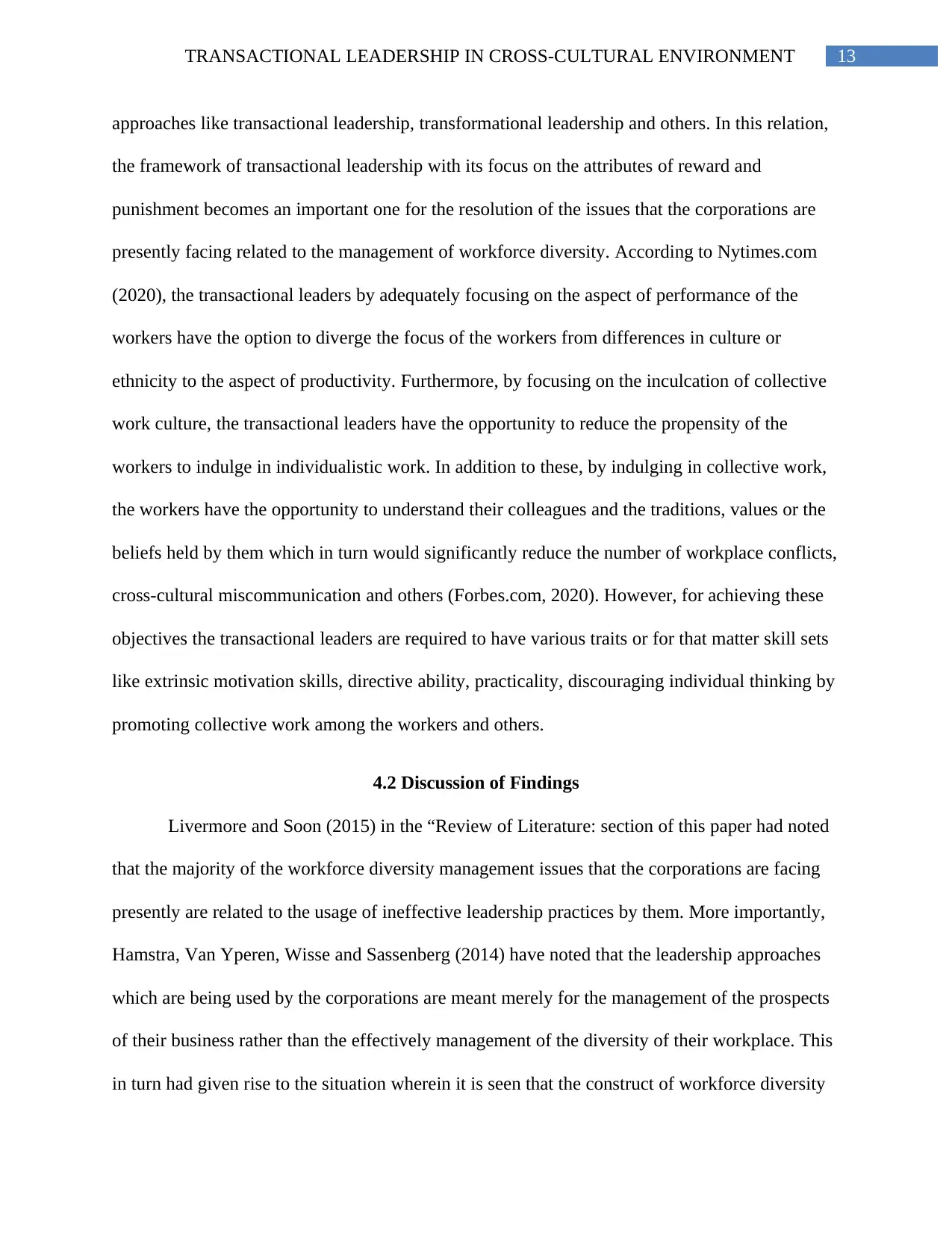
13TRANSACTIONAL LEADERSHIP IN CROSS-CULTURAL ENVIRONMENT
approaches like transactional leadership, transformational leadership and others. In this relation,
the framework of transactional leadership with its focus on the attributes of reward and
punishment becomes an important one for the resolution of the issues that the corporations are
presently facing related to the management of workforce diversity. According to Nytimes.com
(2020), the transactional leaders by adequately focusing on the aspect of performance of the
workers have the option to diverge the focus of the workers from differences in culture or
ethnicity to the aspect of productivity. Furthermore, by focusing on the inculcation of collective
work culture, the transactional leaders have the opportunity to reduce the propensity of the
workers to indulge in individualistic work. In addition to these, by indulging in collective work,
the workers have the opportunity to understand their colleagues and the traditions, values or the
beliefs held by them which in turn would significantly reduce the number of workplace conflicts,
cross-cultural miscommunication and others (Forbes.com, 2020). However, for achieving these
objectives the transactional leaders are required to have various traits or for that matter skill sets
like extrinsic motivation skills, directive ability, practicality, discouraging individual thinking by
promoting collective work among the workers and others.
4.2 Discussion of Findings
Livermore and Soon (2015) in the “Review of Literature: section of this paper had noted
that the majority of the workforce diversity management issues that the corporations are facing
presently are related to the usage of ineffective leadership practices by them. More importantly,
Hamstra, Van Yperen, Wisse and Sassenberg (2014) have noted that the leadership approaches
which are being used by the corporations are meant merely for the management of the prospects
of their business rather than the effectively management of the diversity of their workplace. This
in turn had given rise to the situation wherein it is seen that the construct of workforce diversity
approaches like transactional leadership, transformational leadership and others. In this relation,
the framework of transactional leadership with its focus on the attributes of reward and
punishment becomes an important one for the resolution of the issues that the corporations are
presently facing related to the management of workforce diversity. According to Nytimes.com
(2020), the transactional leaders by adequately focusing on the aspect of performance of the
workers have the option to diverge the focus of the workers from differences in culture or
ethnicity to the aspect of productivity. Furthermore, by focusing on the inculcation of collective
work culture, the transactional leaders have the opportunity to reduce the propensity of the
workers to indulge in individualistic work. In addition to these, by indulging in collective work,
the workers have the opportunity to understand their colleagues and the traditions, values or the
beliefs held by them which in turn would significantly reduce the number of workplace conflicts,
cross-cultural miscommunication and others (Forbes.com, 2020). However, for achieving these
objectives the transactional leaders are required to have various traits or for that matter skill sets
like extrinsic motivation skills, directive ability, practicality, discouraging individual thinking by
promoting collective work among the workers and others.
4.2 Discussion of Findings
Livermore and Soon (2015) in the “Review of Literature: section of this paper had noted
that the majority of the workforce diversity management issues that the corporations are facing
presently are related to the usage of ineffective leadership practices by them. More importantly,
Hamstra, Van Yperen, Wisse and Sassenberg (2014) have noted that the leadership approaches
which are being used by the corporations are meant merely for the management of the prospects
of their business rather than the effectively management of the diversity of their workplace. This
in turn had given rise to the situation wherein it is seen that the construct of workforce diversity
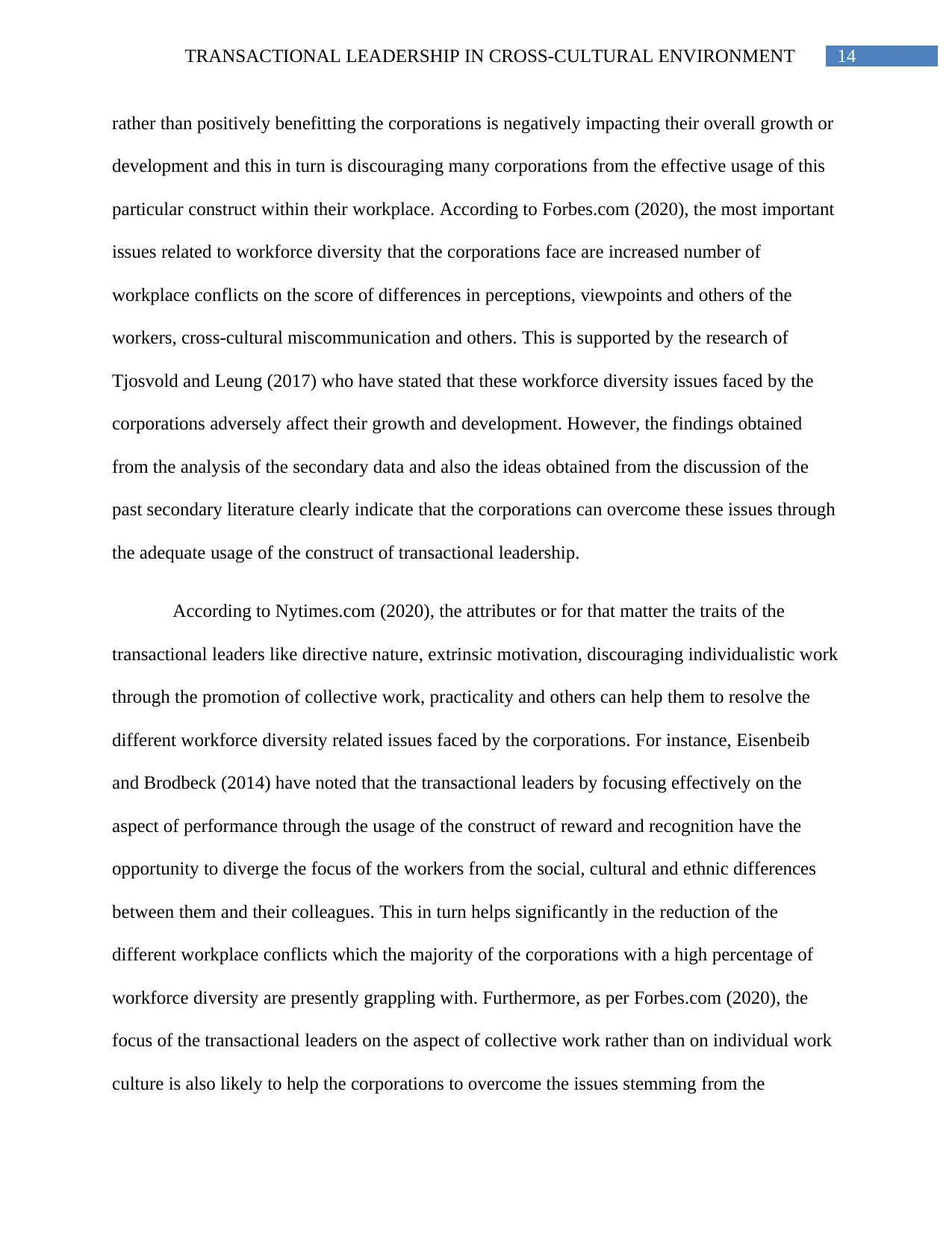
14TRANSACTIONAL LEADERSHIP IN CROSS-CULTURAL ENVIRONMENT
rather than positively benefitting the corporations is negatively impacting their overall growth or
development and this in turn is discouraging many corporations from the effective usage of this
particular construct within their workplace. According to Forbes.com (2020), the most important
issues related to workforce diversity that the corporations face are increased number of
workplace conflicts on the score of differences in perceptions, viewpoints and others of the
workers, cross-cultural miscommunication and others. This is supported by the research of
Tjosvold and Leung (2017) who have stated that these workforce diversity issues faced by the
corporations adversely affect their growth and development. However, the findings obtained
from the analysis of the secondary data and also the ideas obtained from the discussion of the
past secondary literature clearly indicate that the corporations can overcome these issues through
the adequate usage of the construct of transactional leadership.
According to Nytimes.com (2020), the attributes or for that matter the traits of the
transactional leaders like directive nature, extrinsic motivation, discouraging individualistic work
through the promotion of collective work, practicality and others can help them to resolve the
different workforce diversity related issues faced by the corporations. For instance, Eisenbeib
and Brodbeck (2014) have noted that the transactional leaders by focusing effectively on the
aspect of performance through the usage of the construct of reward and recognition have the
opportunity to diverge the focus of the workers from the social, cultural and ethnic differences
between them and their colleagues. This in turn helps significantly in the reduction of the
different workplace conflicts which the majority of the corporations with a high percentage of
workforce diversity are presently grappling with. Furthermore, as per Forbes.com (2020), the
focus of the transactional leaders on the aspect of collective work rather than on individual work
culture is also likely to help the corporations to overcome the issues stemming from the
rather than positively benefitting the corporations is negatively impacting their overall growth or
development and this in turn is discouraging many corporations from the effective usage of this
particular construct within their workplace. According to Forbes.com (2020), the most important
issues related to workforce diversity that the corporations face are increased number of
workplace conflicts on the score of differences in perceptions, viewpoints and others of the
workers, cross-cultural miscommunication and others. This is supported by the research of
Tjosvold and Leung (2017) who have stated that these workforce diversity issues faced by the
corporations adversely affect their growth and development. However, the findings obtained
from the analysis of the secondary data and also the ideas obtained from the discussion of the
past secondary literature clearly indicate that the corporations can overcome these issues through
the adequate usage of the construct of transactional leadership.
According to Nytimes.com (2020), the attributes or for that matter the traits of the
transactional leaders like directive nature, extrinsic motivation, discouraging individualistic work
through the promotion of collective work, practicality and others can help them to resolve the
different workforce diversity related issues faced by the corporations. For instance, Eisenbeib
and Brodbeck (2014) have noted that the transactional leaders by focusing effectively on the
aspect of performance through the usage of the construct of reward and recognition have the
opportunity to diverge the focus of the workers from the social, cultural and ethnic differences
between them and their colleagues. This in turn helps significantly in the reduction of the
different workplace conflicts which the majority of the corporations with a high percentage of
workforce diversity are presently grappling with. Furthermore, as per Forbes.com (2020), the
focus of the transactional leaders on the aspect of collective work rather than on individual work
culture is also likely to help the corporations to overcome the issues stemming from the
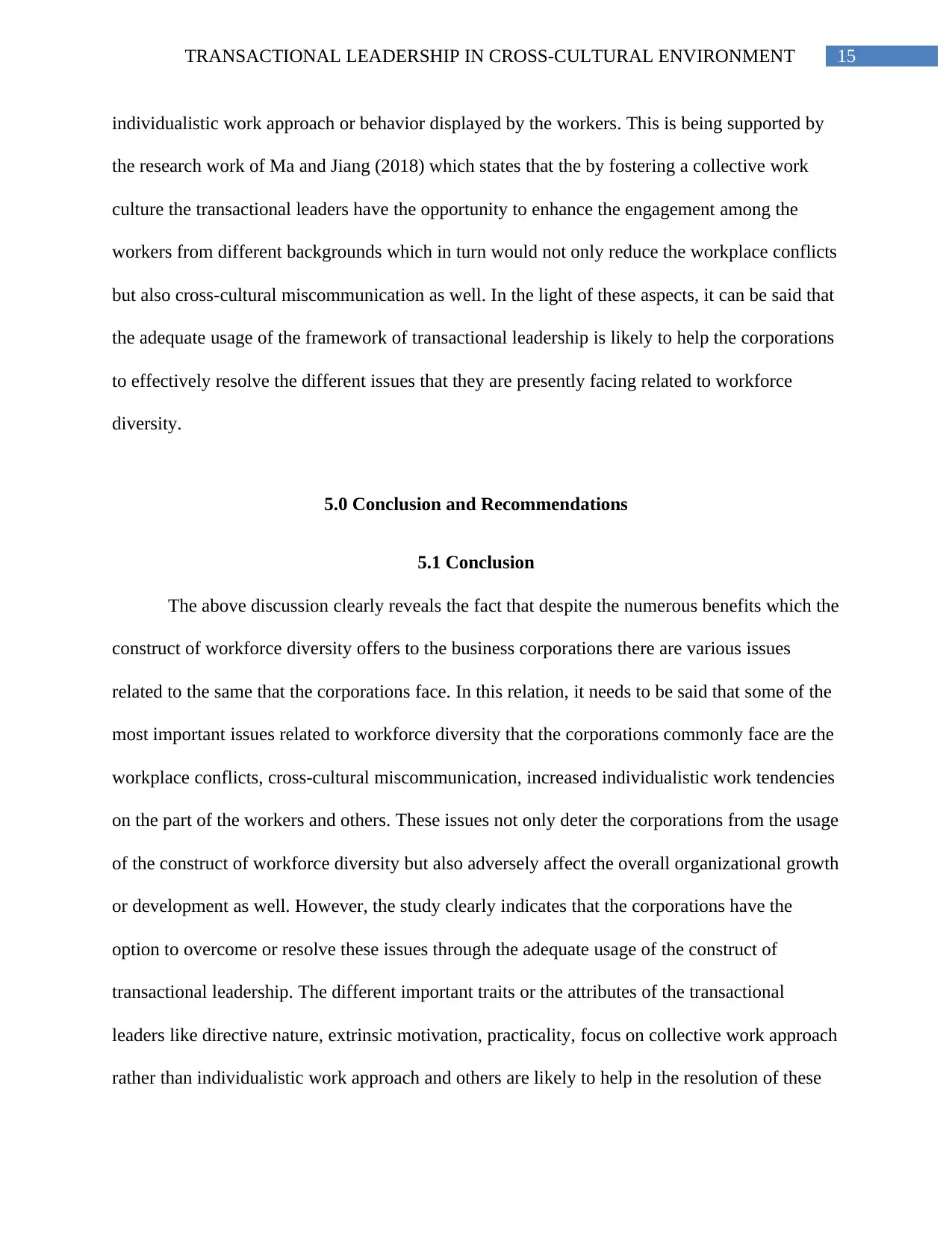
15TRANSACTIONAL LEADERSHIP IN CROSS-CULTURAL ENVIRONMENT
individualistic work approach or behavior displayed by the workers. This is being supported by
the research work of Ma and Jiang (2018) which states that the by fostering a collective work
culture the transactional leaders have the opportunity to enhance the engagement among the
workers from different backgrounds which in turn would not only reduce the workplace conflicts
but also cross-cultural miscommunication as well. In the light of these aspects, it can be said that
the adequate usage of the framework of transactional leadership is likely to help the corporations
to effectively resolve the different issues that they are presently facing related to workforce
diversity.
5.0 Conclusion and Recommendations
5.1 Conclusion
The above discussion clearly reveals the fact that despite the numerous benefits which the
construct of workforce diversity offers to the business corporations there are various issues
related to the same that the corporations face. In this relation, it needs to be said that some of the
most important issues related to workforce diversity that the corporations commonly face are the
workplace conflicts, cross-cultural miscommunication, increased individualistic work tendencies
on the part of the workers and others. These issues not only deter the corporations from the usage
of the construct of workforce diversity but also adversely affect the overall organizational growth
or development as well. However, the study clearly indicates that the corporations have the
option to overcome or resolve these issues through the adequate usage of the construct of
transactional leadership. The different important traits or the attributes of the transactional
leaders like directive nature, extrinsic motivation, practicality, focus on collective work approach
rather than individualistic work approach and others are likely to help in the resolution of these
individualistic work approach or behavior displayed by the workers. This is being supported by
the research work of Ma and Jiang (2018) which states that the by fostering a collective work
culture the transactional leaders have the opportunity to enhance the engagement among the
workers from different backgrounds which in turn would not only reduce the workplace conflicts
but also cross-cultural miscommunication as well. In the light of these aspects, it can be said that
the adequate usage of the framework of transactional leadership is likely to help the corporations
to effectively resolve the different issues that they are presently facing related to workforce
diversity.
5.0 Conclusion and Recommendations
5.1 Conclusion
The above discussion clearly reveals the fact that despite the numerous benefits which the
construct of workforce diversity offers to the business corporations there are various issues
related to the same that the corporations face. In this relation, it needs to be said that some of the
most important issues related to workforce diversity that the corporations commonly face are the
workplace conflicts, cross-cultural miscommunication, increased individualistic work tendencies
on the part of the workers and others. These issues not only deter the corporations from the usage
of the construct of workforce diversity but also adversely affect the overall organizational growth
or development as well. However, the study clearly indicates that the corporations have the
option to overcome or resolve these issues through the adequate usage of the construct of
transactional leadership. The different important traits or the attributes of the transactional
leaders like directive nature, extrinsic motivation, practicality, focus on collective work approach
rather than individualistic work approach and others are likely to help in the resolution of these
Secure Best Marks with AI Grader
Need help grading? Try our AI Grader for instant feedback on your assignments.
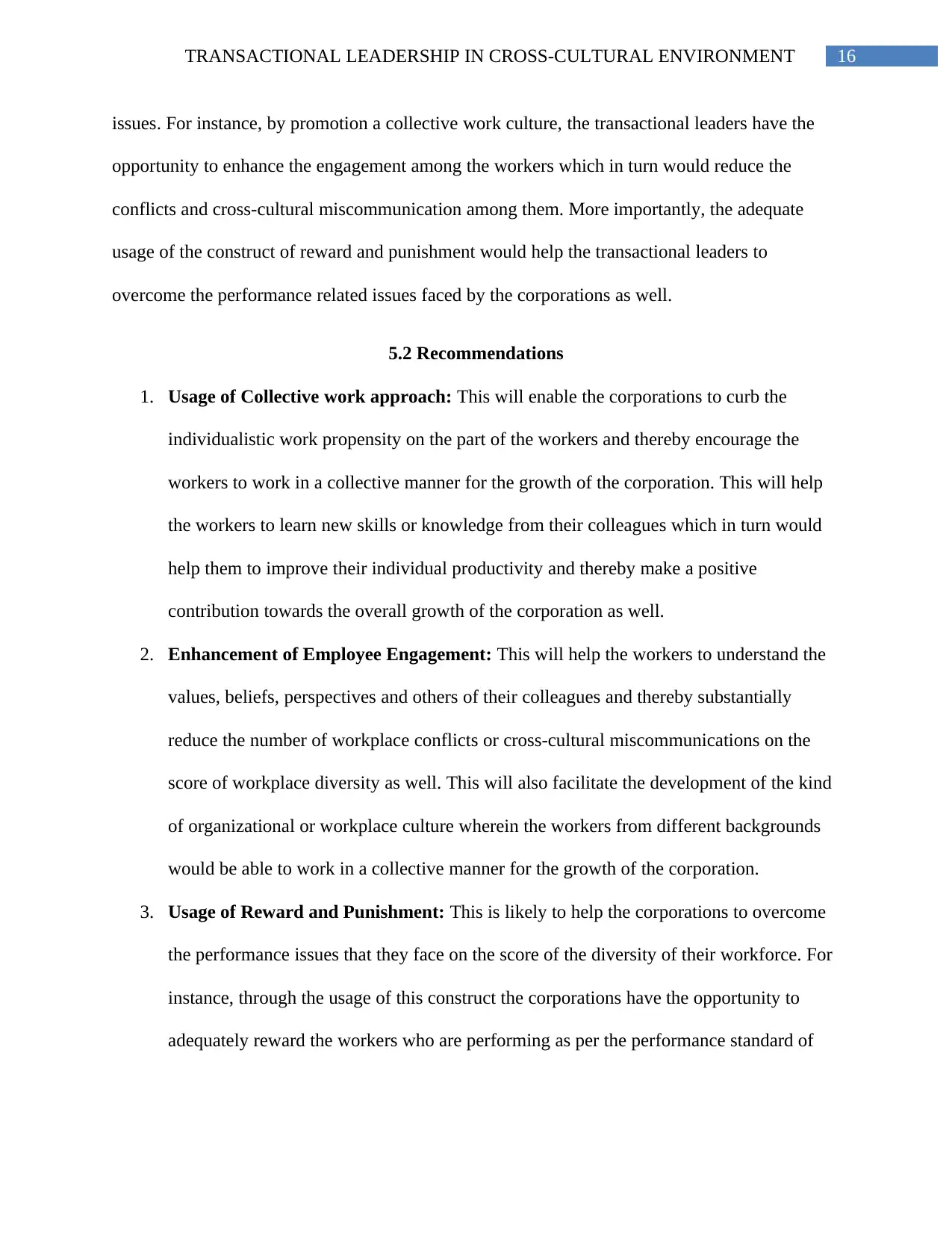
16TRANSACTIONAL LEADERSHIP IN CROSS-CULTURAL ENVIRONMENT
issues. For instance, by promotion a collective work culture, the transactional leaders have the
opportunity to enhance the engagement among the workers which in turn would reduce the
conflicts and cross-cultural miscommunication among them. More importantly, the adequate
usage of the construct of reward and punishment would help the transactional leaders to
overcome the performance related issues faced by the corporations as well.
5.2 Recommendations
1. Usage of Collective work approach: This will enable the corporations to curb the
individualistic work propensity on the part of the workers and thereby encourage the
workers to work in a collective manner for the growth of the corporation. This will help
the workers to learn new skills or knowledge from their colleagues which in turn would
help them to improve their individual productivity and thereby make a positive
contribution towards the overall growth of the corporation as well.
2. Enhancement of Employee Engagement: This will help the workers to understand the
values, beliefs, perspectives and others of their colleagues and thereby substantially
reduce the number of workplace conflicts or cross-cultural miscommunications on the
score of workplace diversity as well. This will also facilitate the development of the kind
of organizational or workplace culture wherein the workers from different backgrounds
would be able to work in a collective manner for the growth of the corporation.
3. Usage of Reward and Punishment: This is likely to help the corporations to overcome
the performance issues that they face on the score of the diversity of their workforce. For
instance, through the usage of this construct the corporations have the opportunity to
adequately reward the workers who are performing as per the performance standard of
issues. For instance, by promotion a collective work culture, the transactional leaders have the
opportunity to enhance the engagement among the workers which in turn would reduce the
conflicts and cross-cultural miscommunication among them. More importantly, the adequate
usage of the construct of reward and punishment would help the transactional leaders to
overcome the performance related issues faced by the corporations as well.
5.2 Recommendations
1. Usage of Collective work approach: This will enable the corporations to curb the
individualistic work propensity on the part of the workers and thereby encourage the
workers to work in a collective manner for the growth of the corporation. This will help
the workers to learn new skills or knowledge from their colleagues which in turn would
help them to improve their individual productivity and thereby make a positive
contribution towards the overall growth of the corporation as well.
2. Enhancement of Employee Engagement: This will help the workers to understand the
values, beliefs, perspectives and others of their colleagues and thereby substantially
reduce the number of workplace conflicts or cross-cultural miscommunications on the
score of workplace diversity as well. This will also facilitate the development of the kind
of organizational or workplace culture wherein the workers from different backgrounds
would be able to work in a collective manner for the growth of the corporation.
3. Usage of Reward and Punishment: This is likely to help the corporations to overcome
the performance issues that they face on the score of the diversity of their workforce. For
instance, through the usage of this construct the corporations have the opportunity to
adequately reward the workers who are performing as per the performance standard of
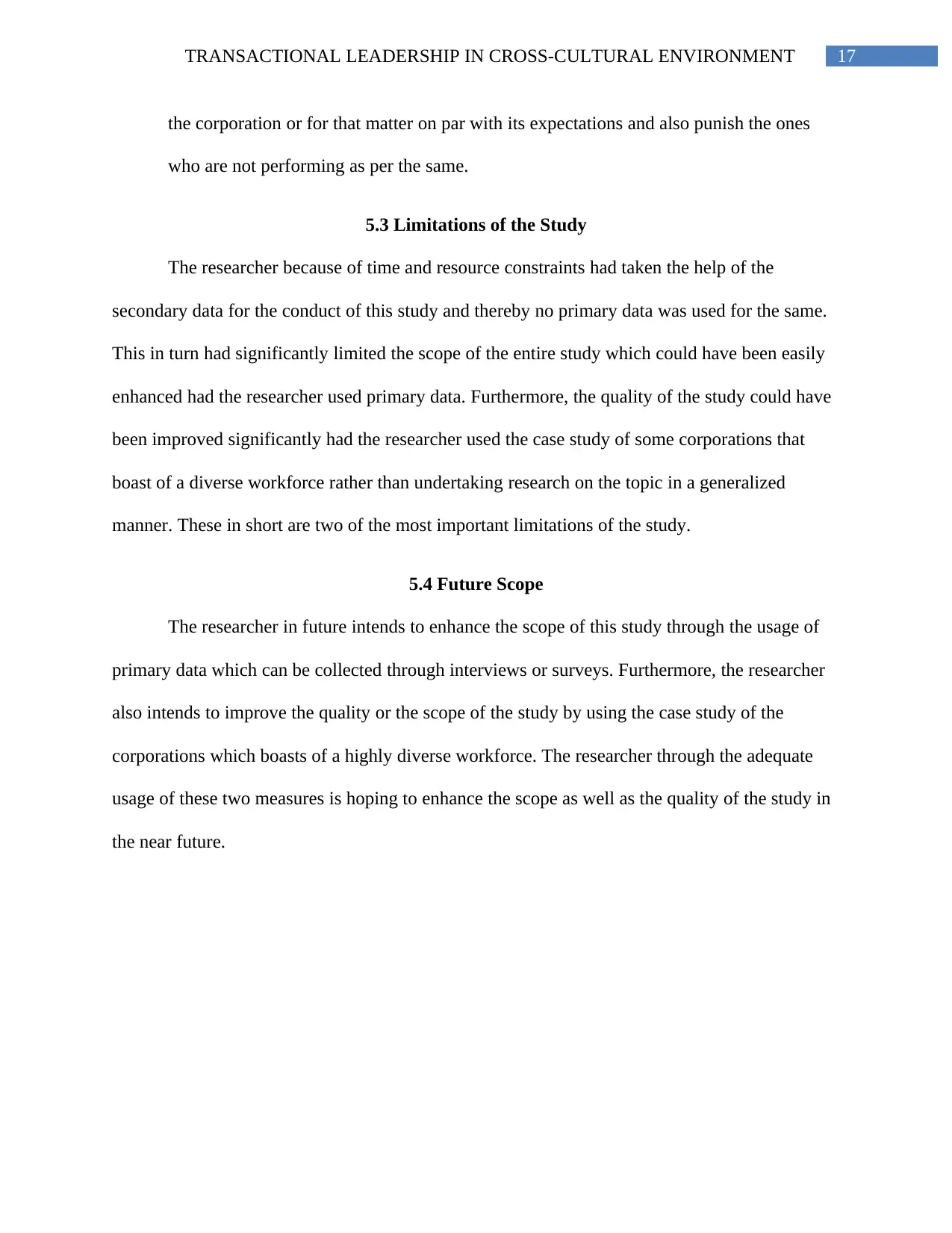
17TRANSACTIONAL LEADERSHIP IN CROSS-CULTURAL ENVIRONMENT
the corporation or for that matter on par with its expectations and also punish the ones
who are not performing as per the same.
5.3 Limitations of the Study
The researcher because of time and resource constraints had taken the help of the
secondary data for the conduct of this study and thereby no primary data was used for the same.
This in turn had significantly limited the scope of the entire study which could have been easily
enhanced had the researcher used primary data. Furthermore, the quality of the study could have
been improved significantly had the researcher used the case study of some corporations that
boast of a diverse workforce rather than undertaking research on the topic in a generalized
manner. These in short are two of the most important limitations of the study.
5.4 Future Scope
The researcher in future intends to enhance the scope of this study through the usage of
primary data which can be collected through interviews or surveys. Furthermore, the researcher
also intends to improve the quality or the scope of the study by using the case study of the
corporations which boasts of a highly diverse workforce. The researcher through the adequate
usage of these two measures is hoping to enhance the scope as well as the quality of the study in
the near future.
the corporation or for that matter on par with its expectations and also punish the ones
who are not performing as per the same.
5.3 Limitations of the Study
The researcher because of time and resource constraints had taken the help of the
secondary data for the conduct of this study and thereby no primary data was used for the same.
This in turn had significantly limited the scope of the entire study which could have been easily
enhanced had the researcher used primary data. Furthermore, the quality of the study could have
been improved significantly had the researcher used the case study of some corporations that
boast of a diverse workforce rather than undertaking research on the topic in a generalized
manner. These in short are two of the most important limitations of the study.
5.4 Future Scope
The researcher in future intends to enhance the scope of this study through the usage of
primary data which can be collected through interviews or surveys. Furthermore, the researcher
also intends to improve the quality or the scope of the study by using the case study of the
corporations which boasts of a highly diverse workforce. The researcher through the adequate
usage of these two measures is hoping to enhance the scope as well as the quality of the study in
the near future.
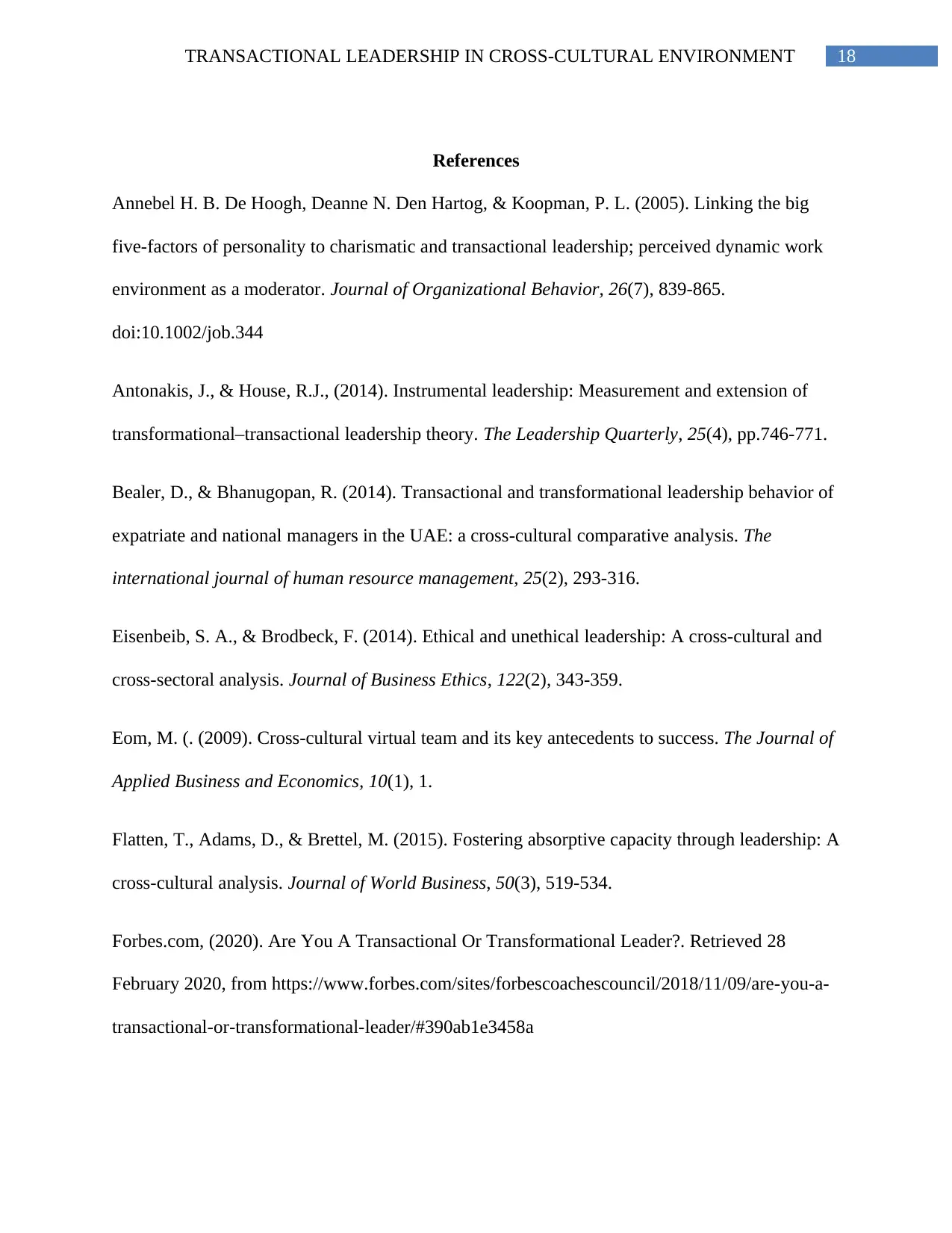
18TRANSACTIONAL LEADERSHIP IN CROSS-CULTURAL ENVIRONMENT
References
Annebel H. B. De Hoogh, Deanne N. Den Hartog, & Koopman, P. L. (2005). Linking the big
five-factors of personality to charismatic and transactional leadership; perceived dynamic work
environment as a moderator. Journal of Organizational Behavior, 26(7), 839-865.
doi:10.1002/job.344
Antonakis, J., & House, R.J., (2014). Instrumental leadership: Measurement and extension of
transformational–transactional leadership theory. The Leadership Quarterly, 25(4), pp.746-771.
Bealer, D., & Bhanugopan, R. (2014). Transactional and transformational leadership behavior of
expatriate and national managers in the UAE: a cross-cultural comparative analysis. The
international journal of human resource management, 25(2), 293-316.
Eisenbeib, S. A., & Brodbeck, F. (2014). Ethical and unethical leadership: A cross-cultural and
cross-sectoral analysis. Journal of Business Ethics, 122(2), 343-359.
Eom, M. (. (2009). Cross-cultural virtual team and its key antecedents to success. The Journal of
Applied Business and Economics, 10(1), 1.
Flatten, T., Adams, D., & Brettel, M. (2015). Fostering absorptive capacity through leadership: A
cross-cultural analysis. Journal of World Business, 50(3), 519-534.
Forbes.com, (2020). Are You A Transactional Or Transformational Leader?. Retrieved 28
February 2020, from https://www.forbes.com/sites/forbescoachescouncil/2018/11/09/are-you-a-
transactional-or-transformational-leader/#390ab1e3458a
References
Annebel H. B. De Hoogh, Deanne N. Den Hartog, & Koopman, P. L. (2005). Linking the big
five-factors of personality to charismatic and transactional leadership; perceived dynamic work
environment as a moderator. Journal of Organizational Behavior, 26(7), 839-865.
doi:10.1002/job.344
Antonakis, J., & House, R.J., (2014). Instrumental leadership: Measurement and extension of
transformational–transactional leadership theory. The Leadership Quarterly, 25(4), pp.746-771.
Bealer, D., & Bhanugopan, R. (2014). Transactional and transformational leadership behavior of
expatriate and national managers in the UAE: a cross-cultural comparative analysis. The
international journal of human resource management, 25(2), 293-316.
Eisenbeib, S. A., & Brodbeck, F. (2014). Ethical and unethical leadership: A cross-cultural and
cross-sectoral analysis. Journal of Business Ethics, 122(2), 343-359.
Eom, M. (. (2009). Cross-cultural virtual team and its key antecedents to success. The Journal of
Applied Business and Economics, 10(1), 1.
Flatten, T., Adams, D., & Brettel, M. (2015). Fostering absorptive capacity through leadership: A
cross-cultural analysis. Journal of World Business, 50(3), 519-534.
Forbes.com, (2020). Are You A Transactional Or Transformational Leader?. Retrieved 28
February 2020, from https://www.forbes.com/sites/forbescoachescouncil/2018/11/09/are-you-a-
transactional-or-transformational-leader/#390ab1e3458a
Paraphrase This Document
Need a fresh take? Get an instant paraphrase of this document with our AI Paraphraser
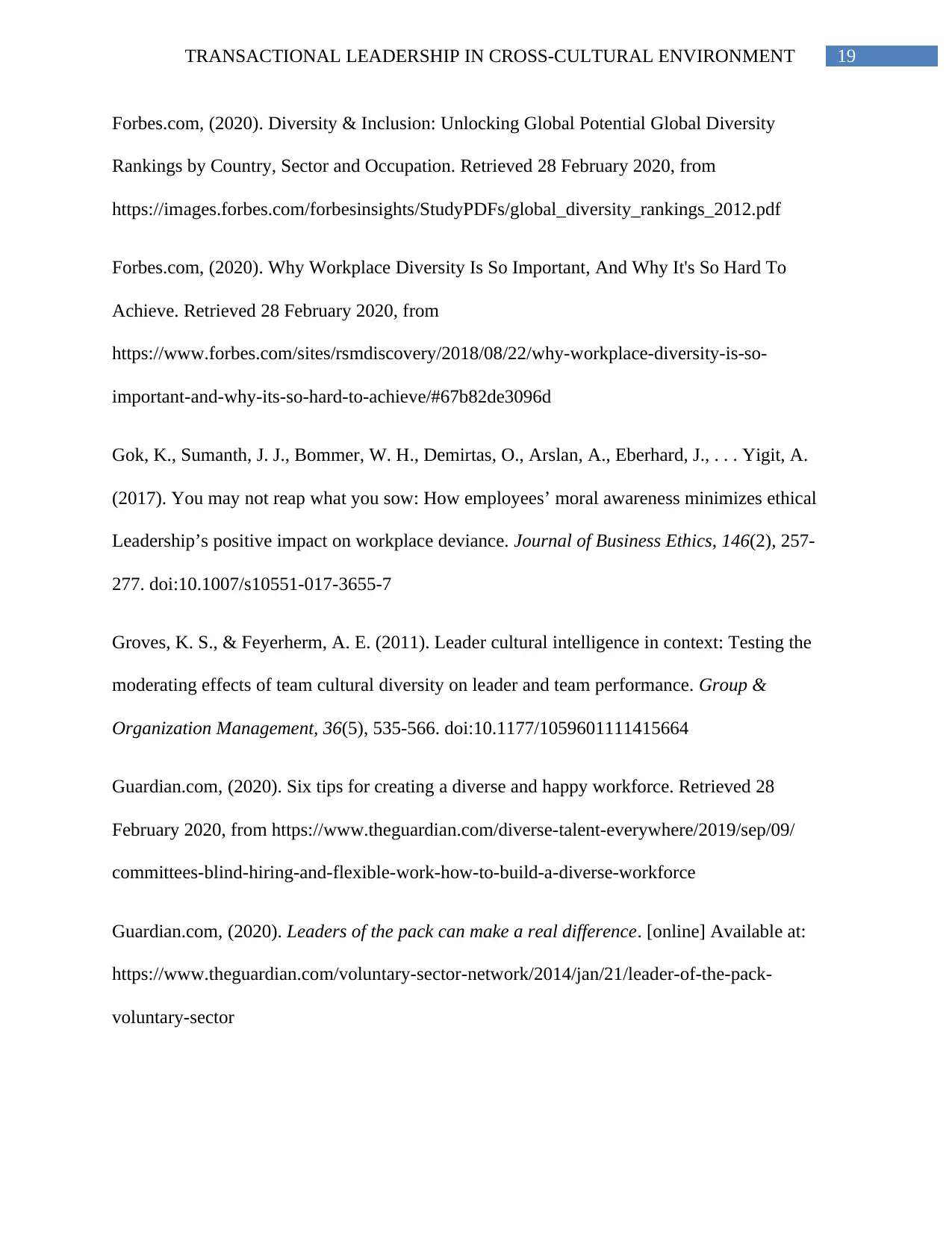
19TRANSACTIONAL LEADERSHIP IN CROSS-CULTURAL ENVIRONMENT
Forbes.com, (2020). Diversity & Inclusion: Unlocking Global Potential Global Diversity
Rankings by Country, Sector and Occupation. Retrieved 28 February 2020, from
https://images.forbes.com/forbesinsights/StudyPDFs/global_diversity_rankings_2012.pdf
Forbes.com, (2020). Why Workplace Diversity Is So Important, And Why It's So Hard To
Achieve. Retrieved 28 February 2020, from
https://www.forbes.com/sites/rsmdiscovery/2018/08/22/why-workplace-diversity-is-so-
important-and-why-its-so-hard-to-achieve/#67b82de3096d
Gok, K., Sumanth, J. J., Bommer, W. H., Demirtas, O., Arslan, A., Eberhard, J., . . . Yigit, A.
(2017). You may not reap what you sow: How employees’ moral awareness minimizes ethical
Leadership’s positive impact on workplace deviance. Journal of Business Ethics, 146(2), 257-
277. doi:10.1007/s10551-017-3655-7
Groves, K. S., & Feyerherm, A. E. (2011). Leader cultural intelligence in context: Testing the
moderating effects of team cultural diversity on leader and team performance. Group &
Organization Management, 36(5), 535-566. doi:10.1177/1059601111415664
Guardian.com, (2020). Six tips for creating a diverse and happy workforce. Retrieved 28
February 2020, from https://www.theguardian.com/diverse-talent-everywhere/2019/sep/09/
committees-blind-hiring-and-flexible-work-how-to-build-a-diverse-workforce
Guardian.com, (2020). Leaders of the pack can make a real difference. [online] Available at:
https://www.theguardian.com/voluntary-sector-network/2014/jan/21/leader-of-the-pack-
voluntary-sector
Forbes.com, (2020). Diversity & Inclusion: Unlocking Global Potential Global Diversity
Rankings by Country, Sector and Occupation. Retrieved 28 February 2020, from
https://images.forbes.com/forbesinsights/StudyPDFs/global_diversity_rankings_2012.pdf
Forbes.com, (2020). Why Workplace Diversity Is So Important, And Why It's So Hard To
Achieve. Retrieved 28 February 2020, from
https://www.forbes.com/sites/rsmdiscovery/2018/08/22/why-workplace-diversity-is-so-
important-and-why-its-so-hard-to-achieve/#67b82de3096d
Gok, K., Sumanth, J. J., Bommer, W. H., Demirtas, O., Arslan, A., Eberhard, J., . . . Yigit, A.
(2017). You may not reap what you sow: How employees’ moral awareness minimizes ethical
Leadership’s positive impact on workplace deviance. Journal of Business Ethics, 146(2), 257-
277. doi:10.1007/s10551-017-3655-7
Groves, K. S., & Feyerherm, A. E. (2011). Leader cultural intelligence in context: Testing the
moderating effects of team cultural diversity on leader and team performance. Group &
Organization Management, 36(5), 535-566. doi:10.1177/1059601111415664
Guardian.com, (2020). Six tips for creating a diverse and happy workforce. Retrieved 28
February 2020, from https://www.theguardian.com/diverse-talent-everywhere/2019/sep/09/
committees-blind-hiring-and-flexible-work-how-to-build-a-diverse-workforce
Guardian.com, (2020). Leaders of the pack can make a real difference. [online] Available at:
https://www.theguardian.com/voluntary-sector-network/2014/jan/21/leader-of-the-pack-
voluntary-sector
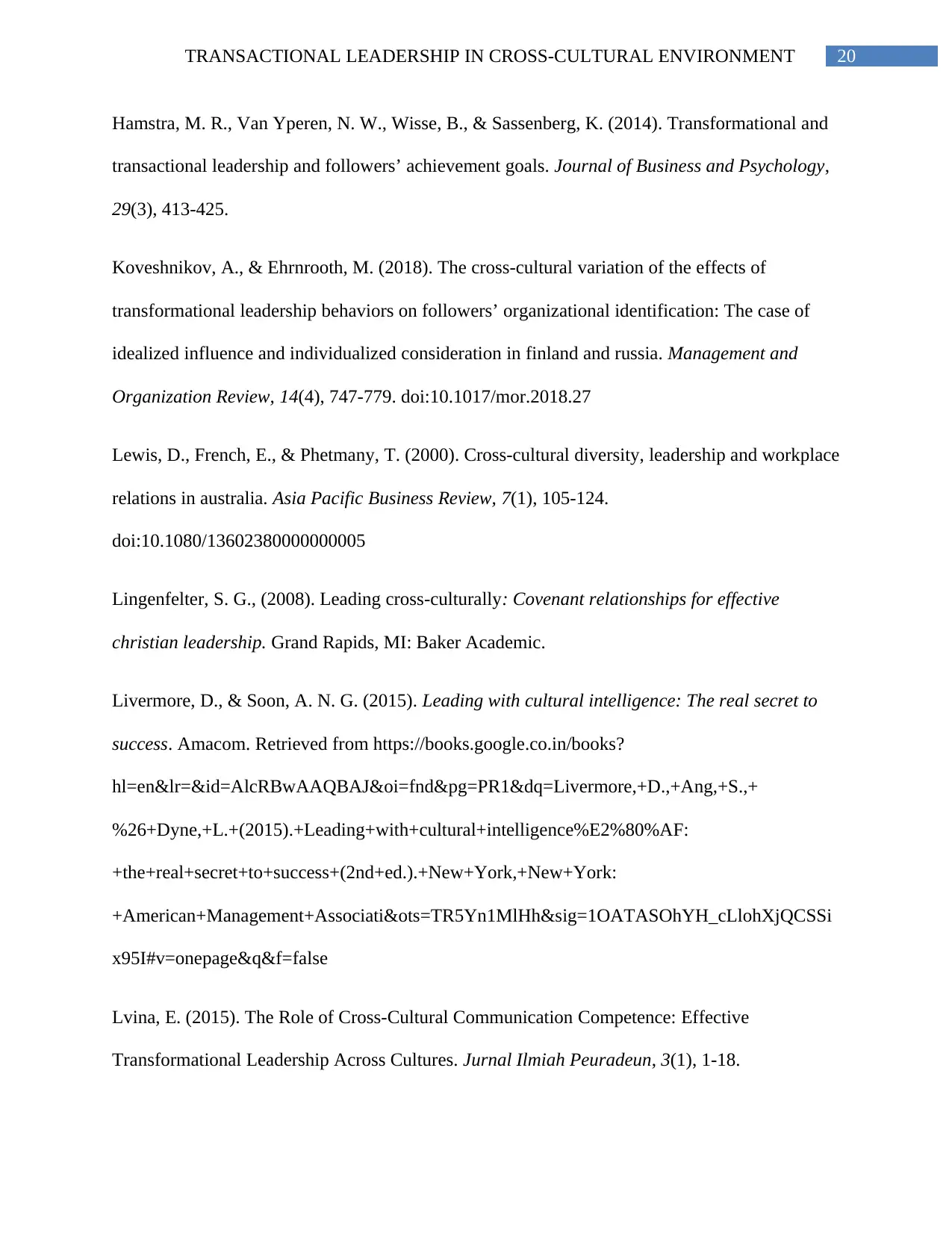
20TRANSACTIONAL LEADERSHIP IN CROSS-CULTURAL ENVIRONMENT
Hamstra, M. R., Van Yperen, N. W., Wisse, B., & Sassenberg, K. (2014). Transformational and
transactional leadership and followers’ achievement goals. Journal of Business and Psychology,
29(3), 413-425.
Koveshnikov, A., & Ehrnrooth, M. (2018). The cross-cultural variation of the effects of
transformational leadership behaviors on followers’ organizational identification: The case of
idealized influence and individualized consideration in finland and russia. Management and
Organization Review, 14(4), 747-779. doi:10.1017/mor.2018.27
Lewis, D., French, E., & Phetmany, T. (2000). Cross-cultural diversity, leadership and workplace
relations in australia. Asia Pacific Business Review, 7(1), 105-124.
doi:10.1080/13602380000000005
Lingenfelter, S. G., (2008). Leading cross-culturally: Covenant relationships for effective
christian leadership. Grand Rapids, MI: Baker Academic.
Livermore, D., & Soon, A. N. G. (2015). Leading with cultural intelligence: The real secret to
success. Amacom. Retrieved from https://books.google.co.in/books?
hl=en&lr=&id=AlcRBwAAQBAJ&oi=fnd&pg=PR1&dq=Livermore,+D.,+Ang,+S.,+
%26+Dyne,+L.+(2015).+Leading+with+cultural+intelligence%E2%80%AF:
+the+real+secret+to+success+(2nd+ed.).+New+York,+New+York:
+American+Management+Associati&ots=TR5Yn1MlHh&sig=1OATASOhYH_cLlohXjQCSSi
x95I#v=onepage&q&f=false
Lvina, E. (2015). The Role of Cross-Cultural Communication Competence: Effective
Transformational Leadership Across Cultures. Jurnal Ilmiah Peuradeun, 3(1), 1-18.
Hamstra, M. R., Van Yperen, N. W., Wisse, B., & Sassenberg, K. (2014). Transformational and
transactional leadership and followers’ achievement goals. Journal of Business and Psychology,
29(3), 413-425.
Koveshnikov, A., & Ehrnrooth, M. (2018). The cross-cultural variation of the effects of
transformational leadership behaviors on followers’ organizational identification: The case of
idealized influence and individualized consideration in finland and russia. Management and
Organization Review, 14(4), 747-779. doi:10.1017/mor.2018.27
Lewis, D., French, E., & Phetmany, T. (2000). Cross-cultural diversity, leadership and workplace
relations in australia. Asia Pacific Business Review, 7(1), 105-124.
doi:10.1080/13602380000000005
Lingenfelter, S. G., (2008). Leading cross-culturally: Covenant relationships for effective
christian leadership. Grand Rapids, MI: Baker Academic.
Livermore, D., & Soon, A. N. G. (2015). Leading with cultural intelligence: The real secret to
success. Amacom. Retrieved from https://books.google.co.in/books?
hl=en&lr=&id=AlcRBwAAQBAJ&oi=fnd&pg=PR1&dq=Livermore,+D.,+Ang,+S.,+
%26+Dyne,+L.+(2015).+Leading+with+cultural+intelligence%E2%80%AF:
+the+real+secret+to+success+(2nd+ed.).+New+York,+New+York:
+American+Management+Associati&ots=TR5Yn1MlHh&sig=1OATASOhYH_cLlohXjQCSSi
x95I#v=onepage&q&f=false
Lvina, E. (2015). The Role of Cross-Cultural Communication Competence: Effective
Transformational Leadership Across Cultures. Jurnal Ilmiah Peuradeun, 3(1), 1-18.
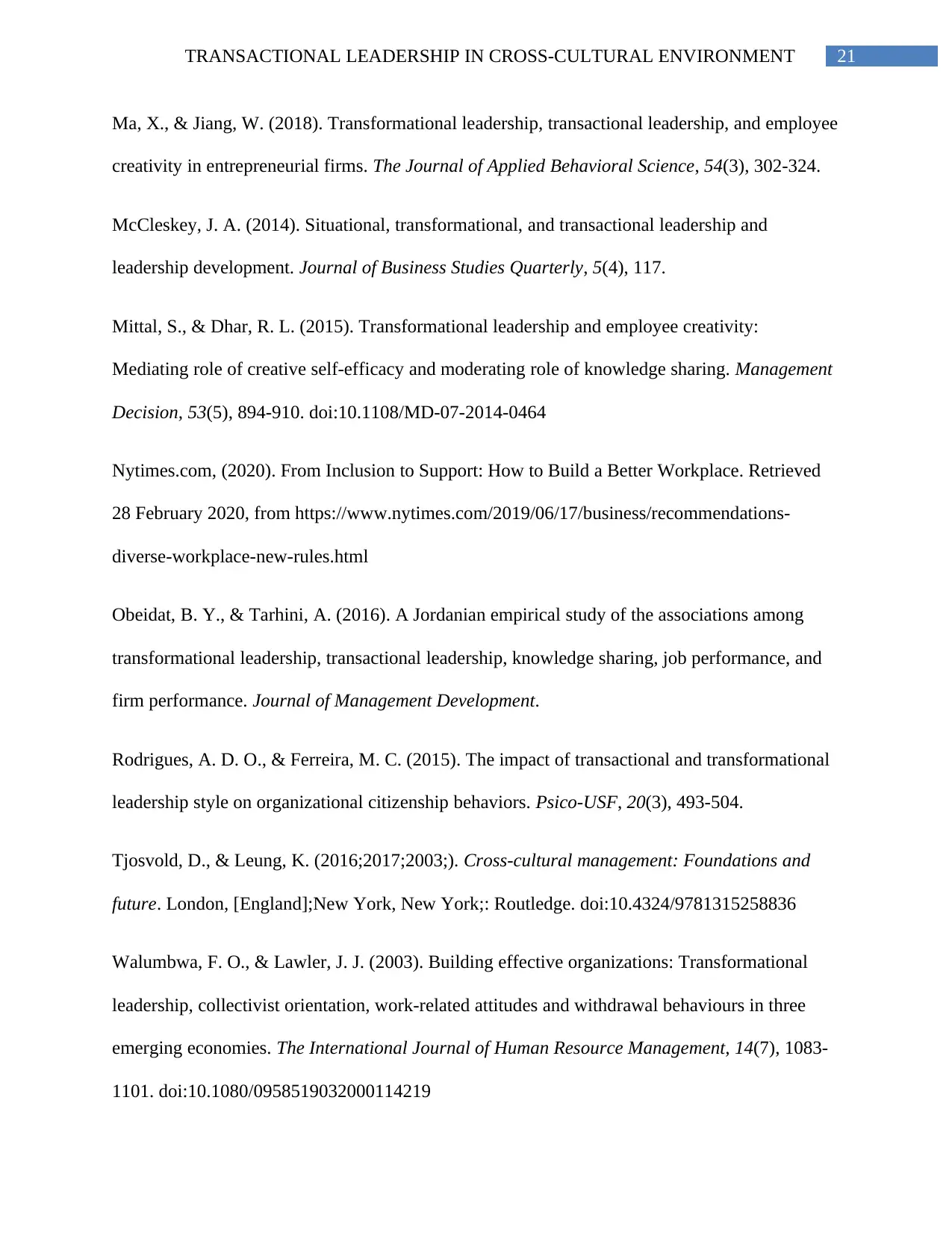
21TRANSACTIONAL LEADERSHIP IN CROSS-CULTURAL ENVIRONMENT
Ma, X., & Jiang, W. (2018). Transformational leadership, transactional leadership, and employee
creativity in entrepreneurial firms. The Journal of Applied Behavioral Science, 54(3), 302-324.
McCleskey, J. A. (2014). Situational, transformational, and transactional leadership and
leadership development. Journal of Business Studies Quarterly, 5(4), 117.
Mittal, S., & Dhar, R. L. (2015). Transformational leadership and employee creativity:
Mediating role of creative self-efficacy and moderating role of knowledge sharing. Management
Decision, 53(5), 894-910. doi:10.1108/MD-07-2014-0464
Nytimes.com, (2020). From Inclusion to Support: How to Build a Better Workplace. Retrieved
28 February 2020, from https://www.nytimes.com/2019/06/17/business/recommendations-
diverse-workplace-new-rules.html
Obeidat, B. Y., & Tarhini, A. (2016). A Jordanian empirical study of the associations among
transformational leadership, transactional leadership, knowledge sharing, job performance, and
firm performance. Journal of Management Development.
Rodrigues, A. D. O., & Ferreira, M. C. (2015). The impact of transactional and transformational
leadership style on organizational citizenship behaviors. Psico-USF, 20(3), 493-504.
Tjosvold, D., & Leung, K. (2016;2017;2003;). Cross-cultural management: Foundations and
future. London, [England];New York, New York;: Routledge. doi:10.4324/9781315258836
Walumbwa, F. O., & Lawler, J. J. (2003). Building effective organizations: Transformational
leadership, collectivist orientation, work-related attitudes and withdrawal behaviours in three
emerging economies. The International Journal of Human Resource Management, 14(7), 1083-
1101. doi:10.1080/0958519032000114219
Ma, X., & Jiang, W. (2018). Transformational leadership, transactional leadership, and employee
creativity in entrepreneurial firms. The Journal of Applied Behavioral Science, 54(3), 302-324.
McCleskey, J. A. (2014). Situational, transformational, and transactional leadership and
leadership development. Journal of Business Studies Quarterly, 5(4), 117.
Mittal, S., & Dhar, R. L. (2015). Transformational leadership and employee creativity:
Mediating role of creative self-efficacy and moderating role of knowledge sharing. Management
Decision, 53(5), 894-910. doi:10.1108/MD-07-2014-0464
Nytimes.com, (2020). From Inclusion to Support: How to Build a Better Workplace. Retrieved
28 February 2020, from https://www.nytimes.com/2019/06/17/business/recommendations-
diverse-workplace-new-rules.html
Obeidat, B. Y., & Tarhini, A. (2016). A Jordanian empirical study of the associations among
transformational leadership, transactional leadership, knowledge sharing, job performance, and
firm performance. Journal of Management Development.
Rodrigues, A. D. O., & Ferreira, M. C. (2015). The impact of transactional and transformational
leadership style on organizational citizenship behaviors. Psico-USF, 20(3), 493-504.
Tjosvold, D., & Leung, K. (2016;2017;2003;). Cross-cultural management: Foundations and
future. London, [England];New York, New York;: Routledge. doi:10.4324/9781315258836
Walumbwa, F. O., & Lawler, J. J. (2003). Building effective organizations: Transformational
leadership, collectivist orientation, work-related attitudes and withdrawal behaviours in three
emerging economies. The International Journal of Human Resource Management, 14(7), 1083-
1101. doi:10.1080/0958519032000114219
Secure Best Marks with AI Grader
Need help grading? Try our AI Grader for instant feedback on your assignments.
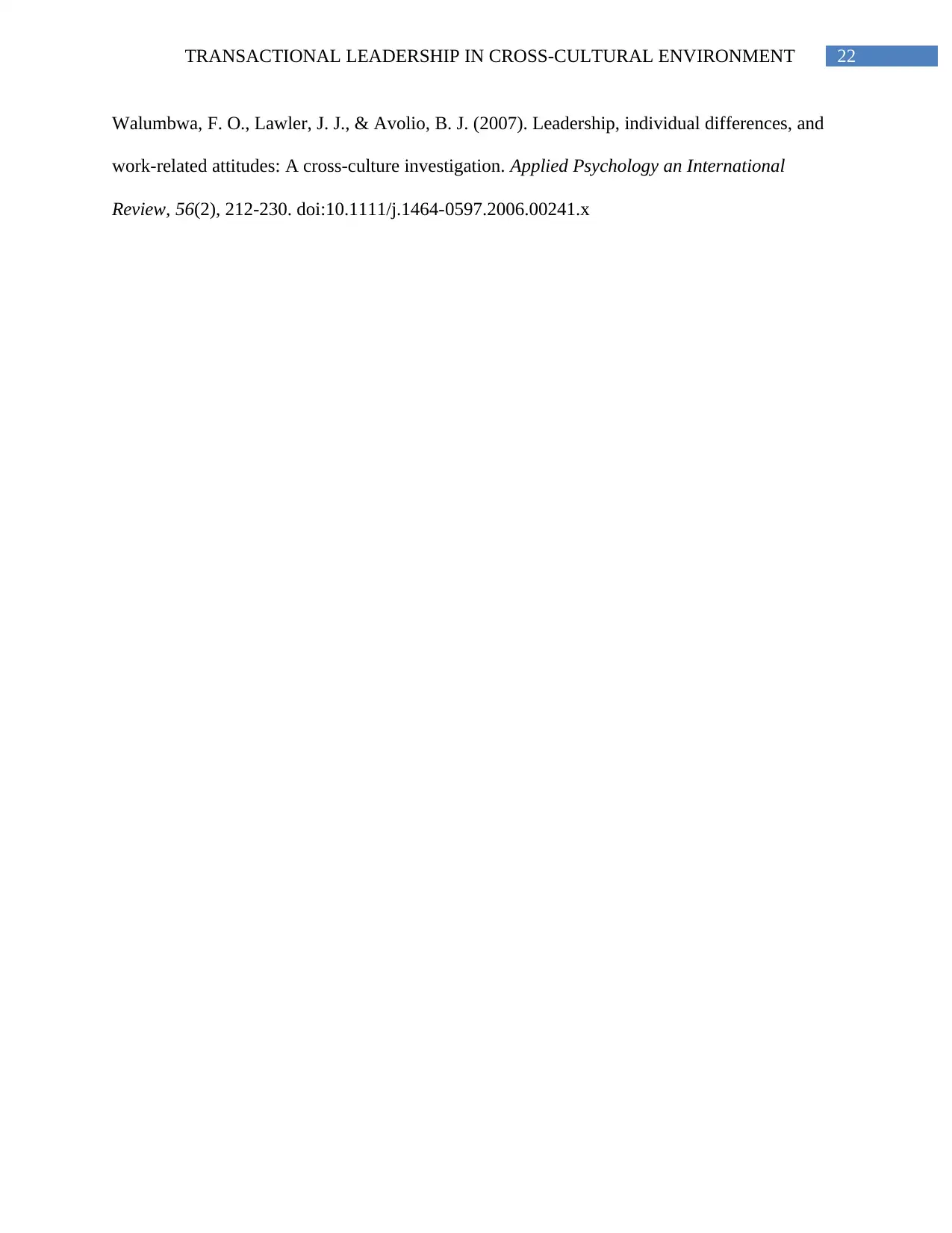
22TRANSACTIONAL LEADERSHIP IN CROSS-CULTURAL ENVIRONMENT
Walumbwa, F. O., Lawler, J. J., & Avolio, B. J. (2007). Leadership, individual differences, and
work-related attitudes: A cross-culture investigation. Applied Psychology an International
Review, 56(2), 212-230. doi:10.1111/j.1464-0597.2006.00241.x
Walumbwa, F. O., Lawler, J. J., & Avolio, B. J. (2007). Leadership, individual differences, and
work-related attitudes: A cross-culture investigation. Applied Psychology an International
Review, 56(2), 212-230. doi:10.1111/j.1464-0597.2006.00241.x
1 out of 23
Related Documents
Your All-in-One AI-Powered Toolkit for Academic Success.
+13062052269
info@desklib.com
Available 24*7 on WhatsApp / Email
![[object Object]](/_next/static/media/star-bottom.7253800d.svg)
Unlock your academic potential
© 2024 | Zucol Services PVT LTD | All rights reserved.





